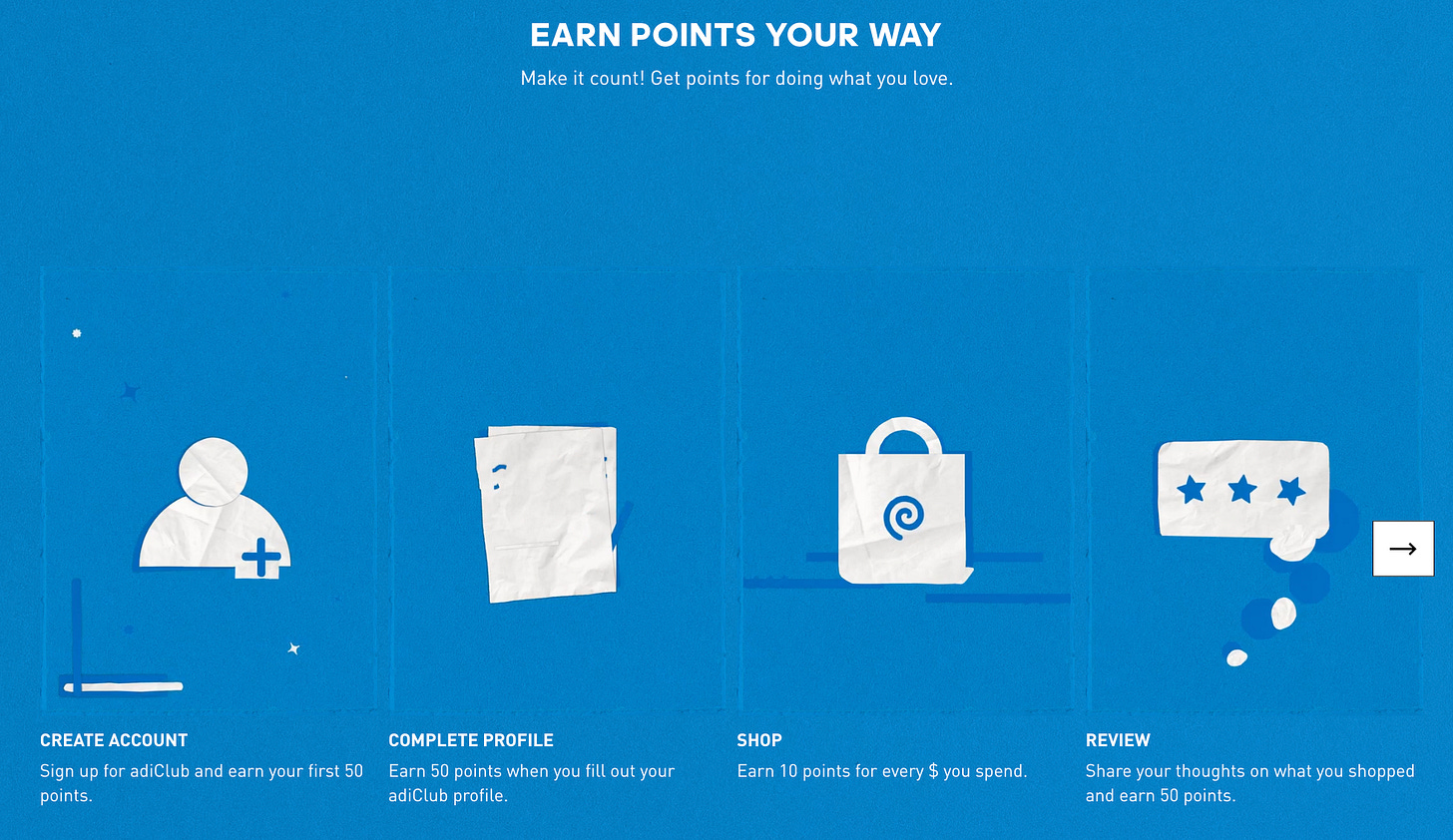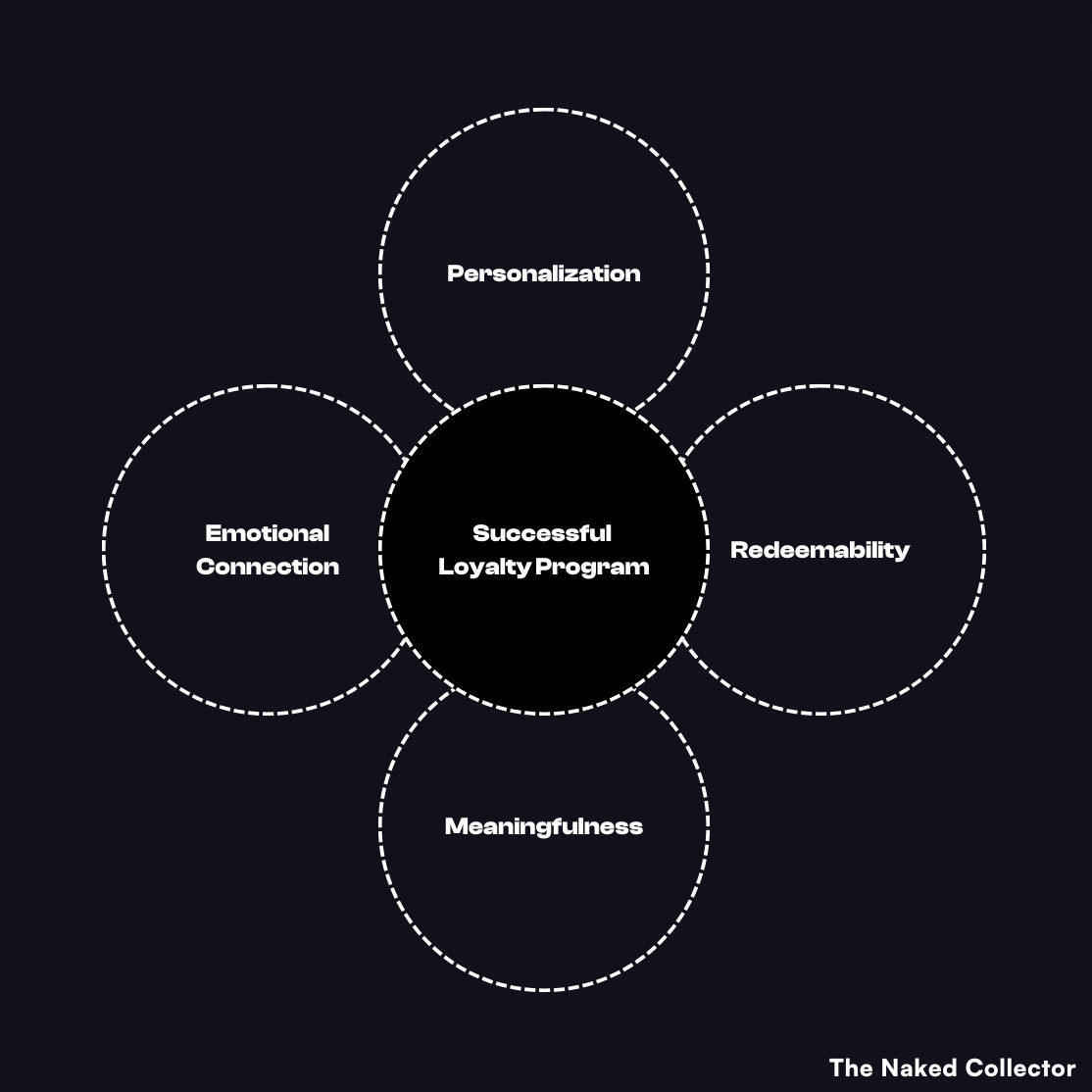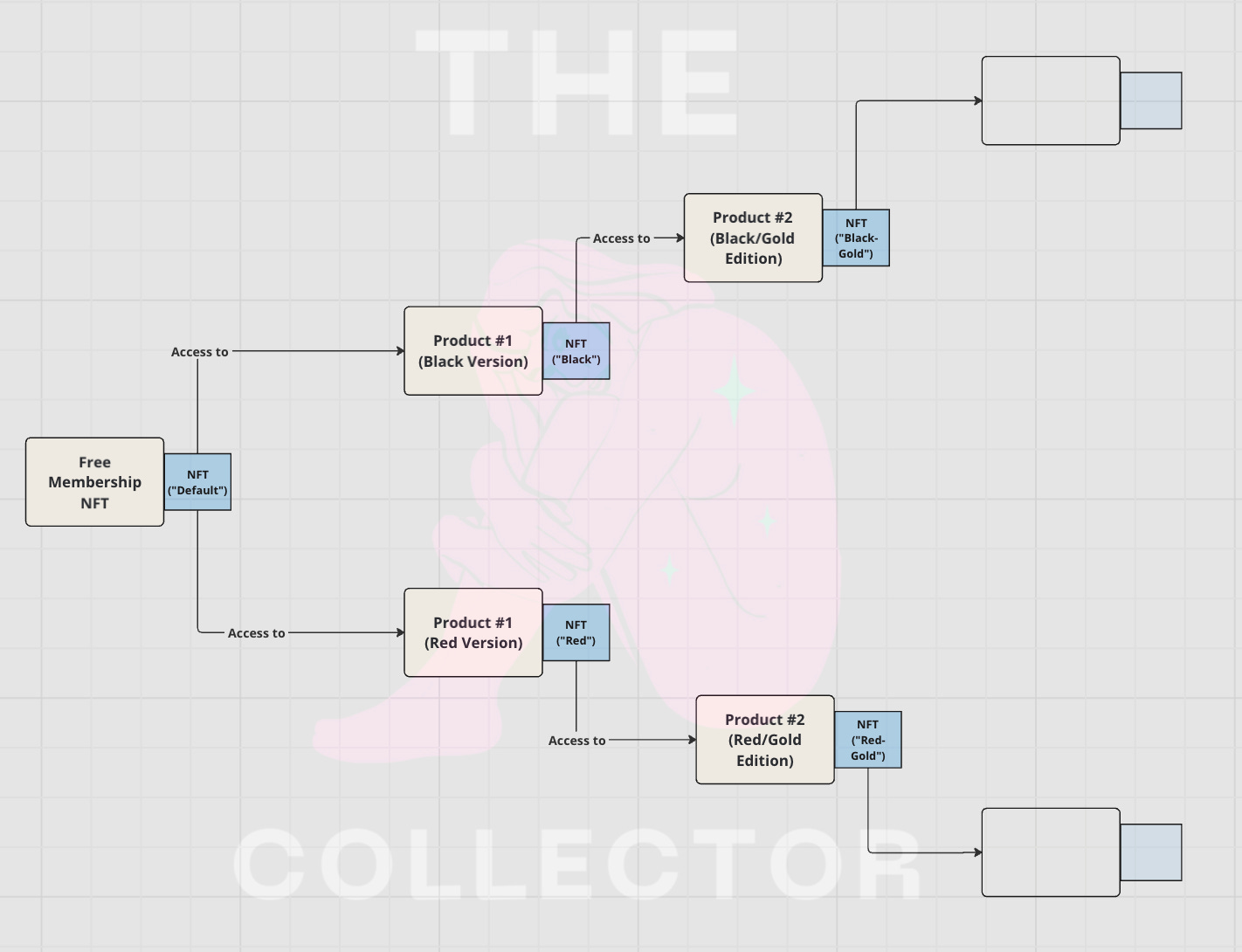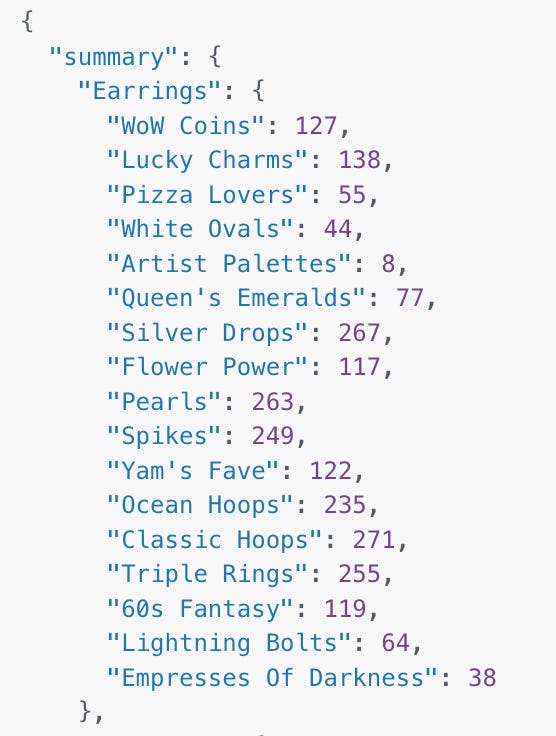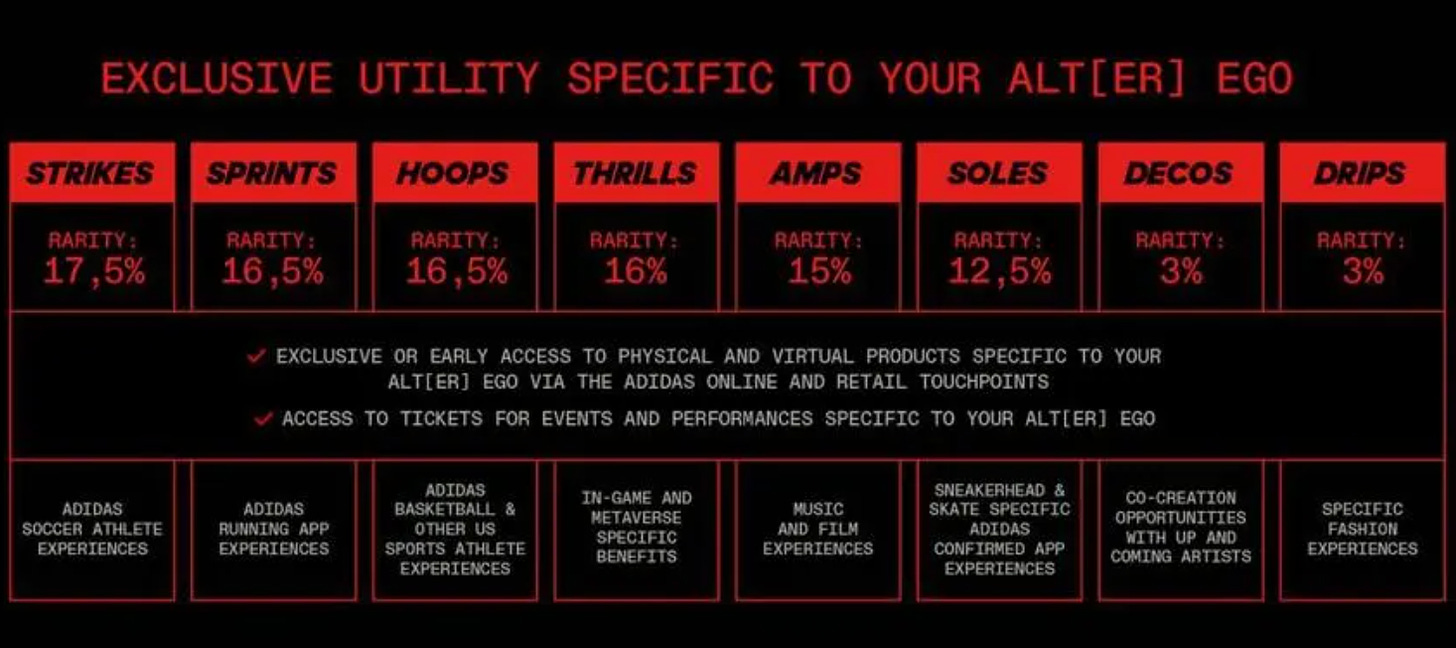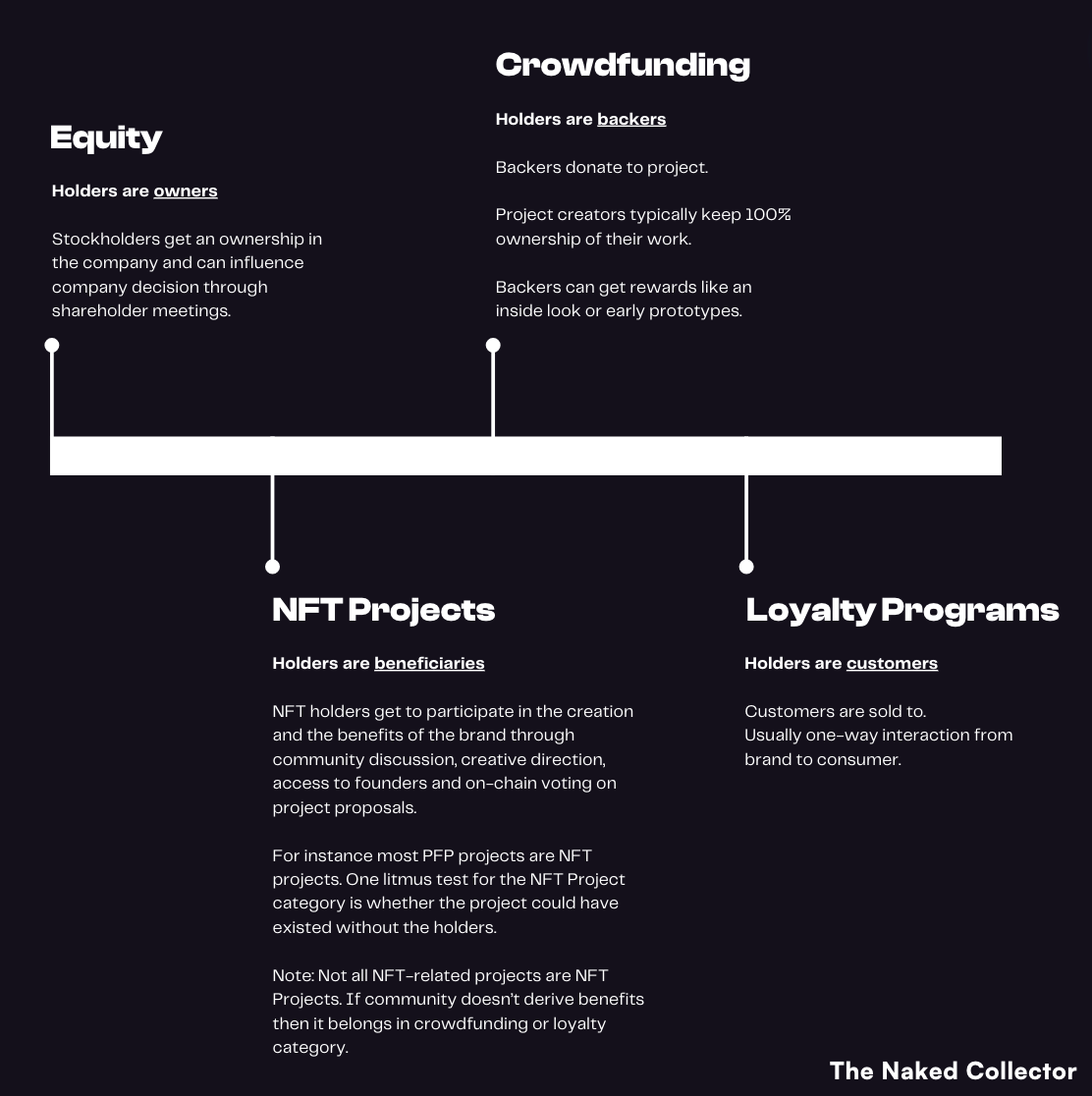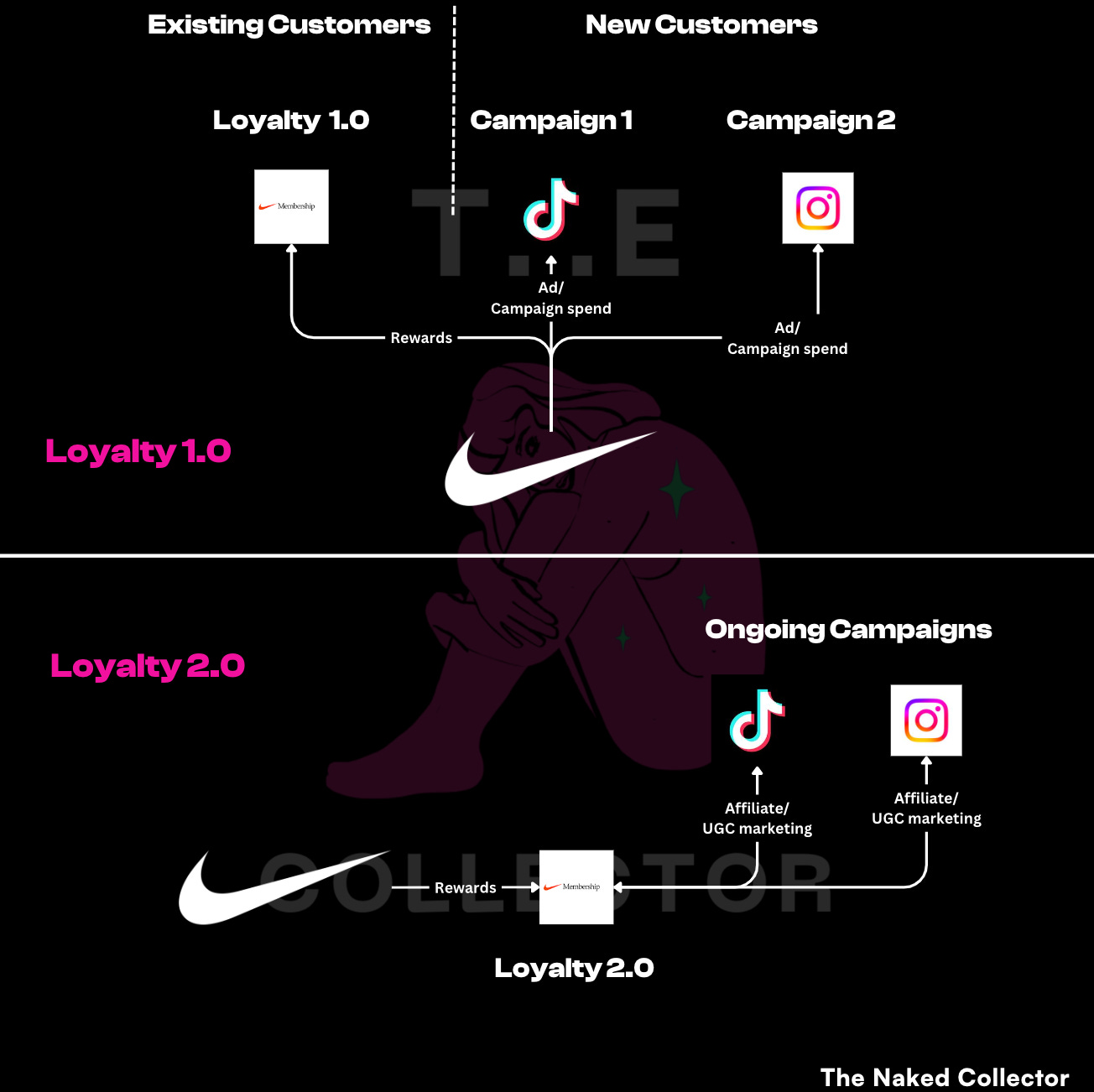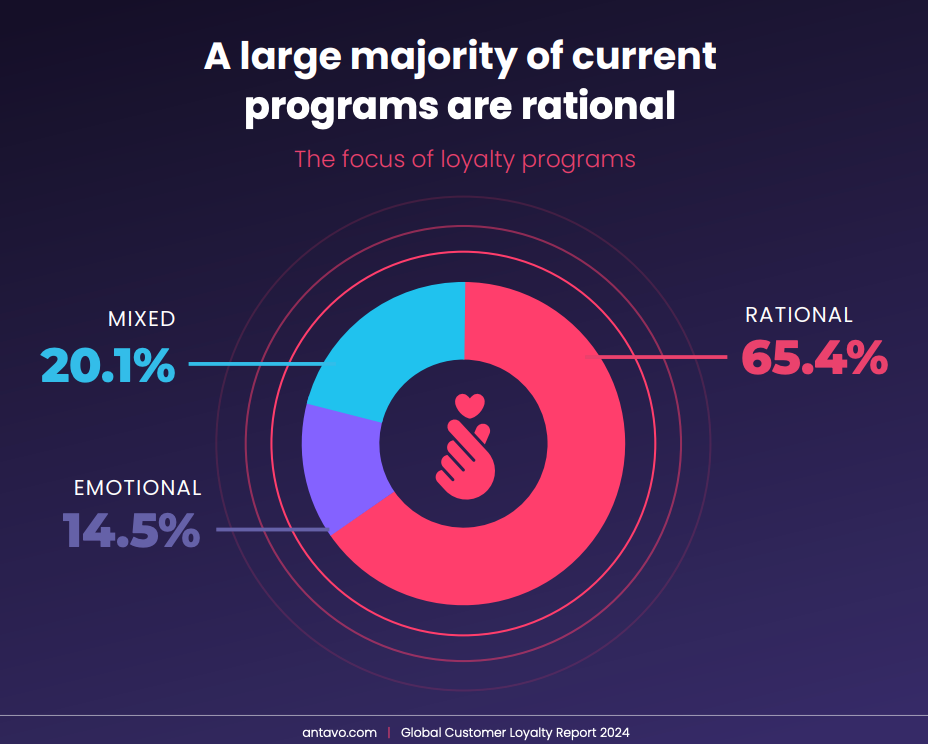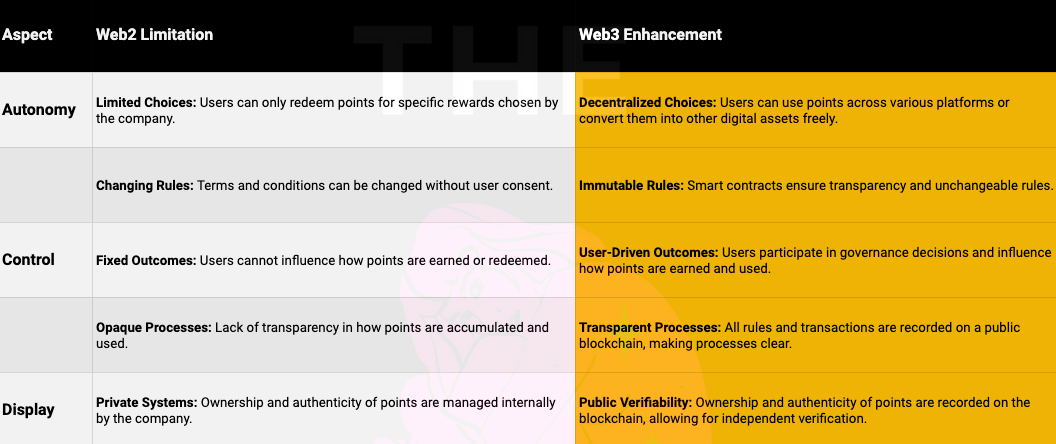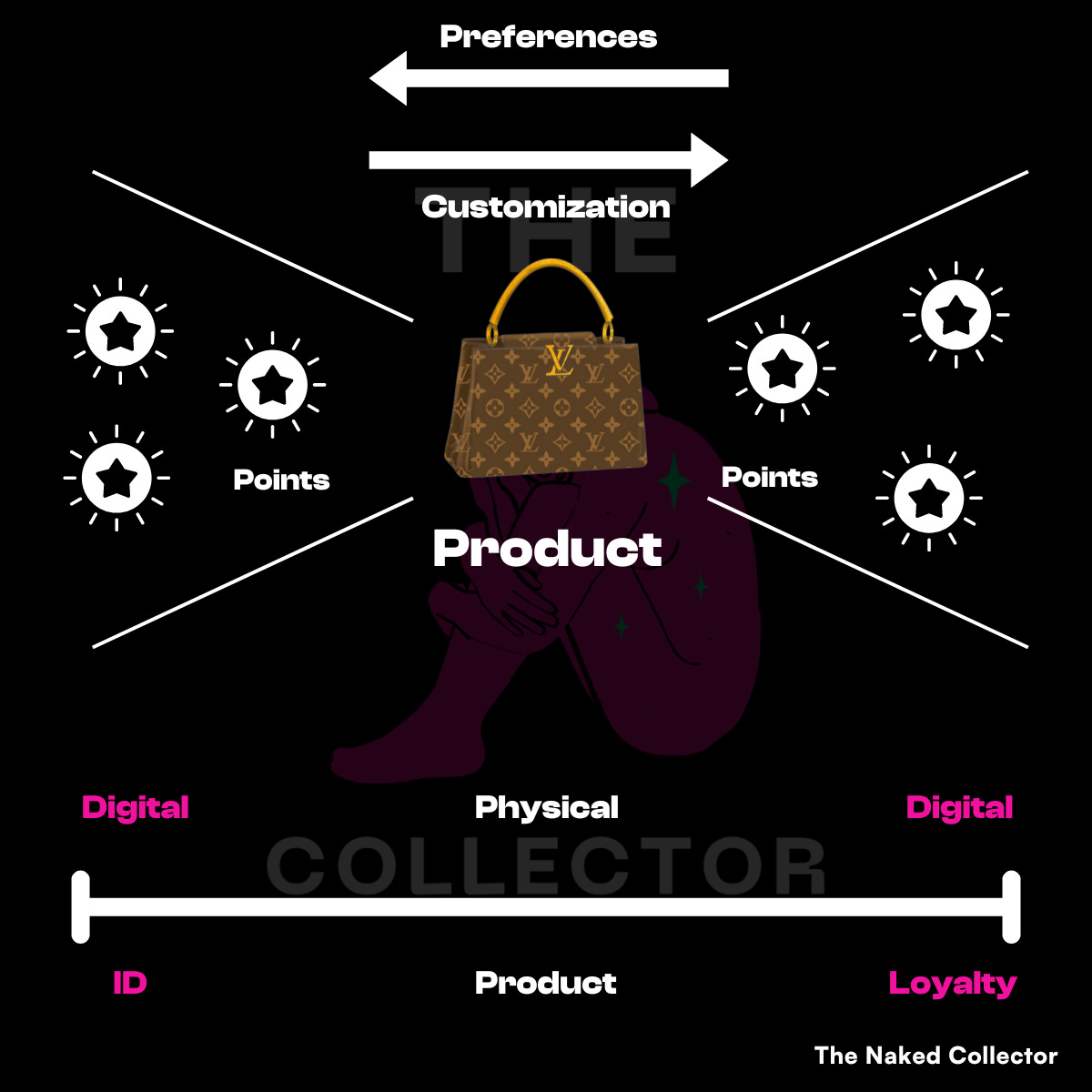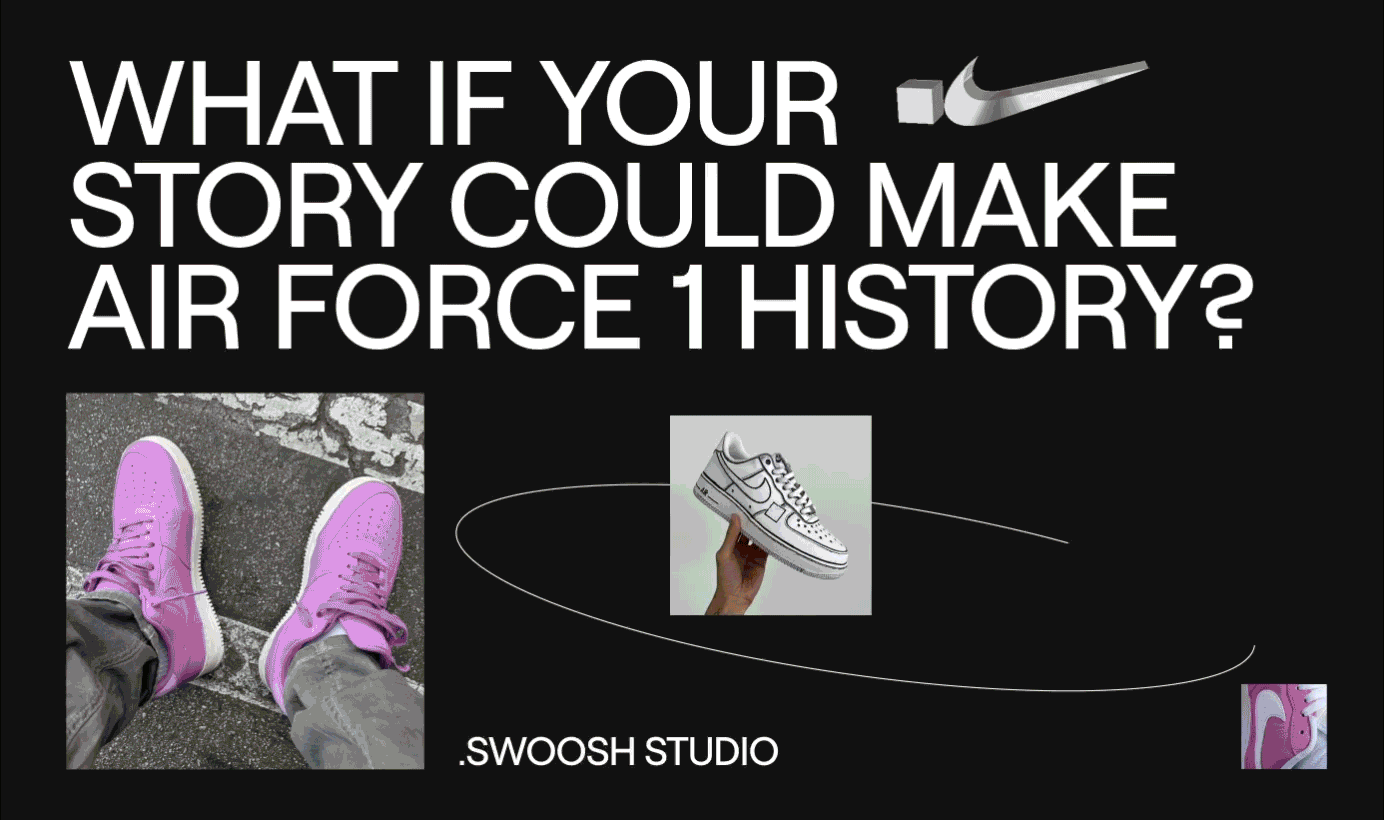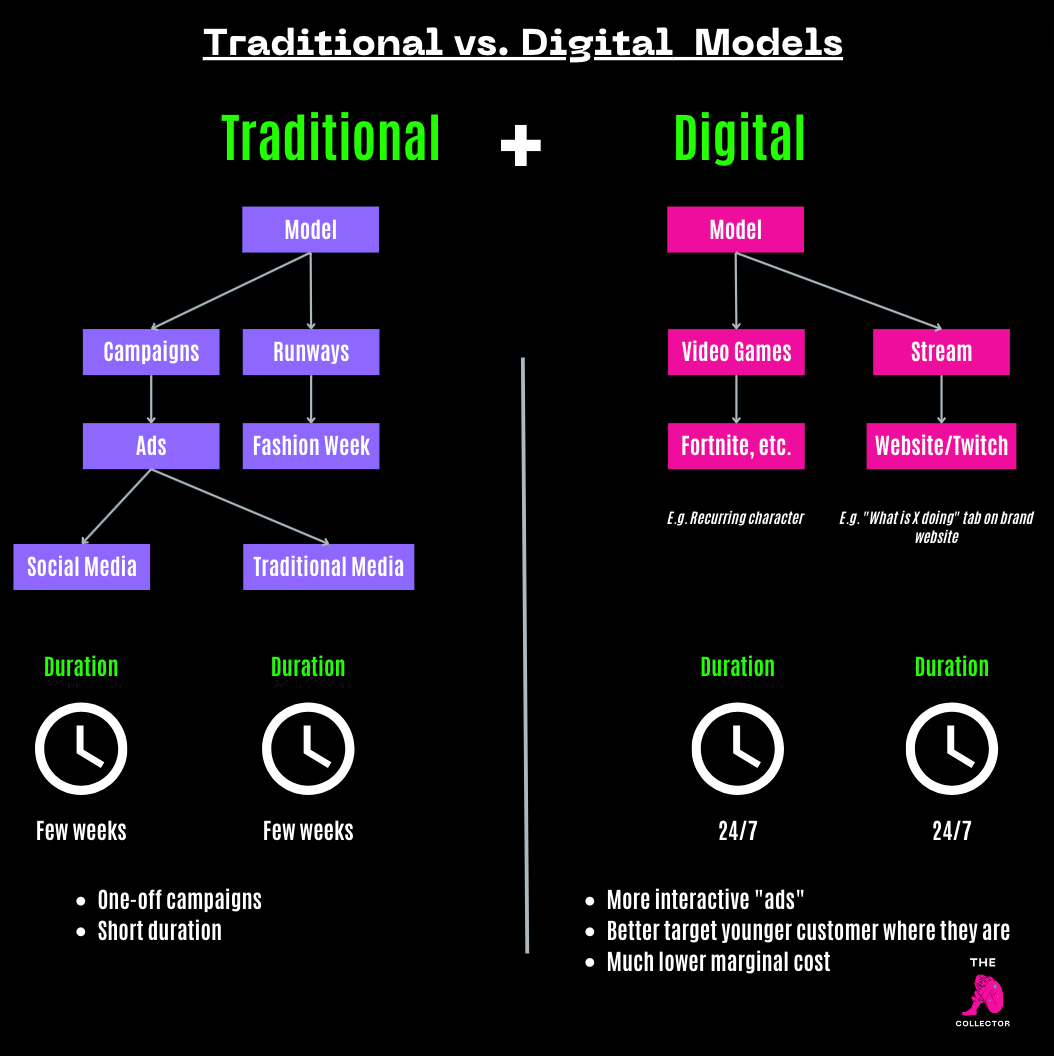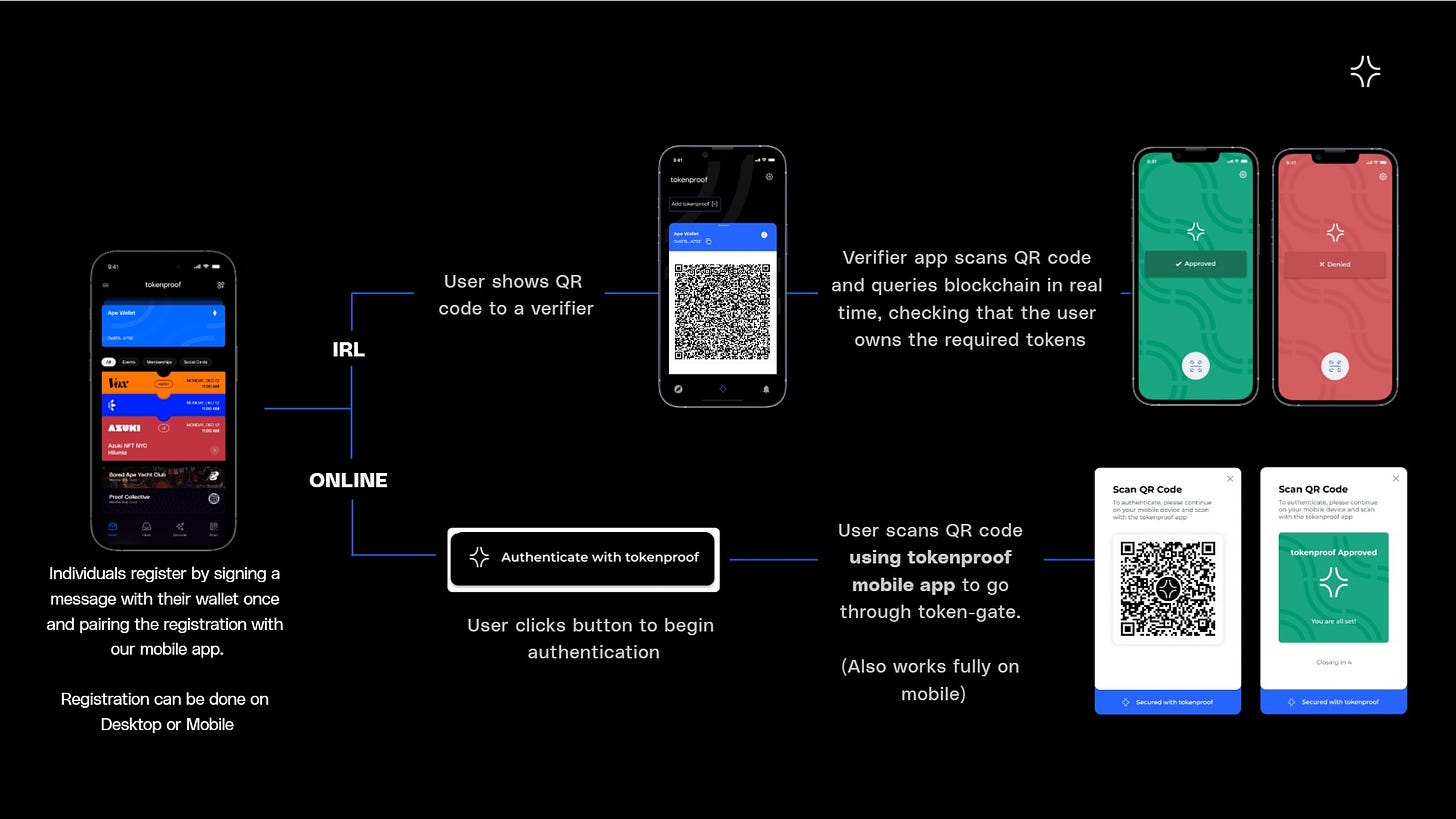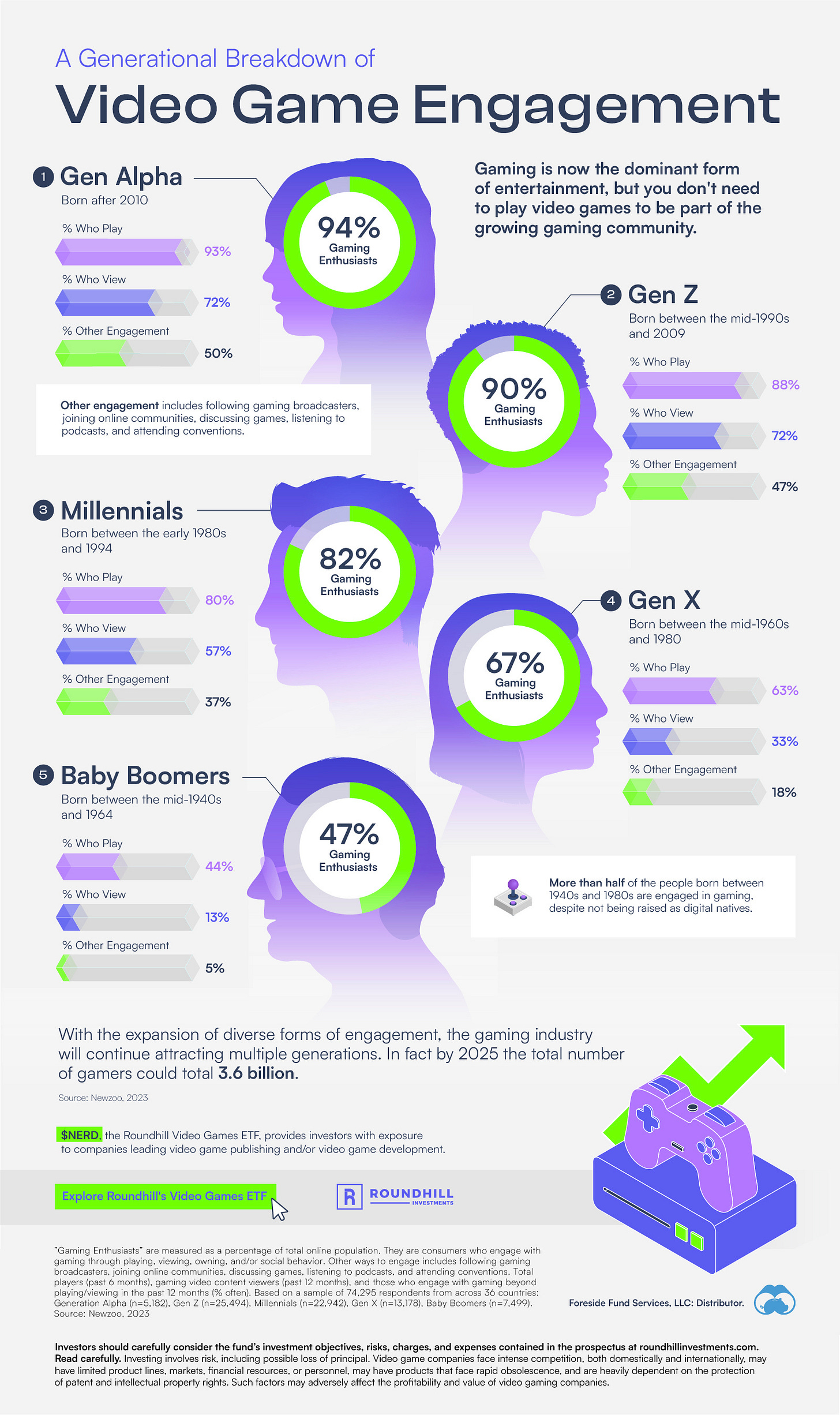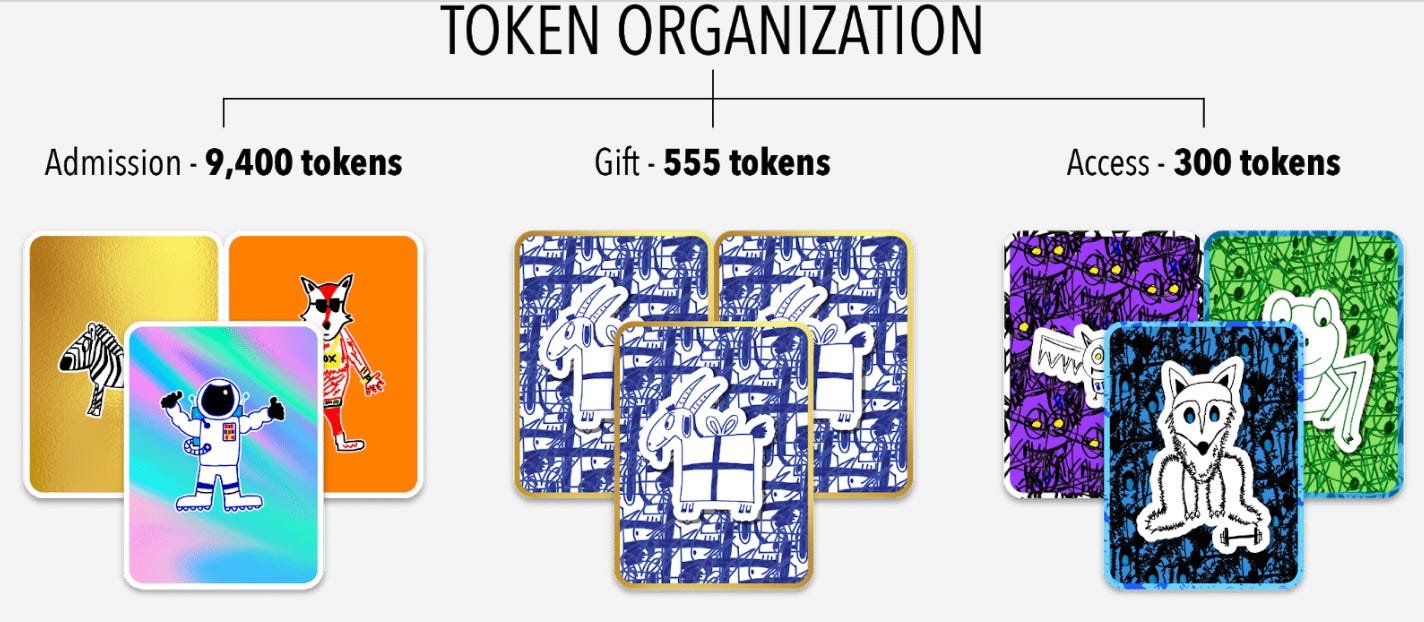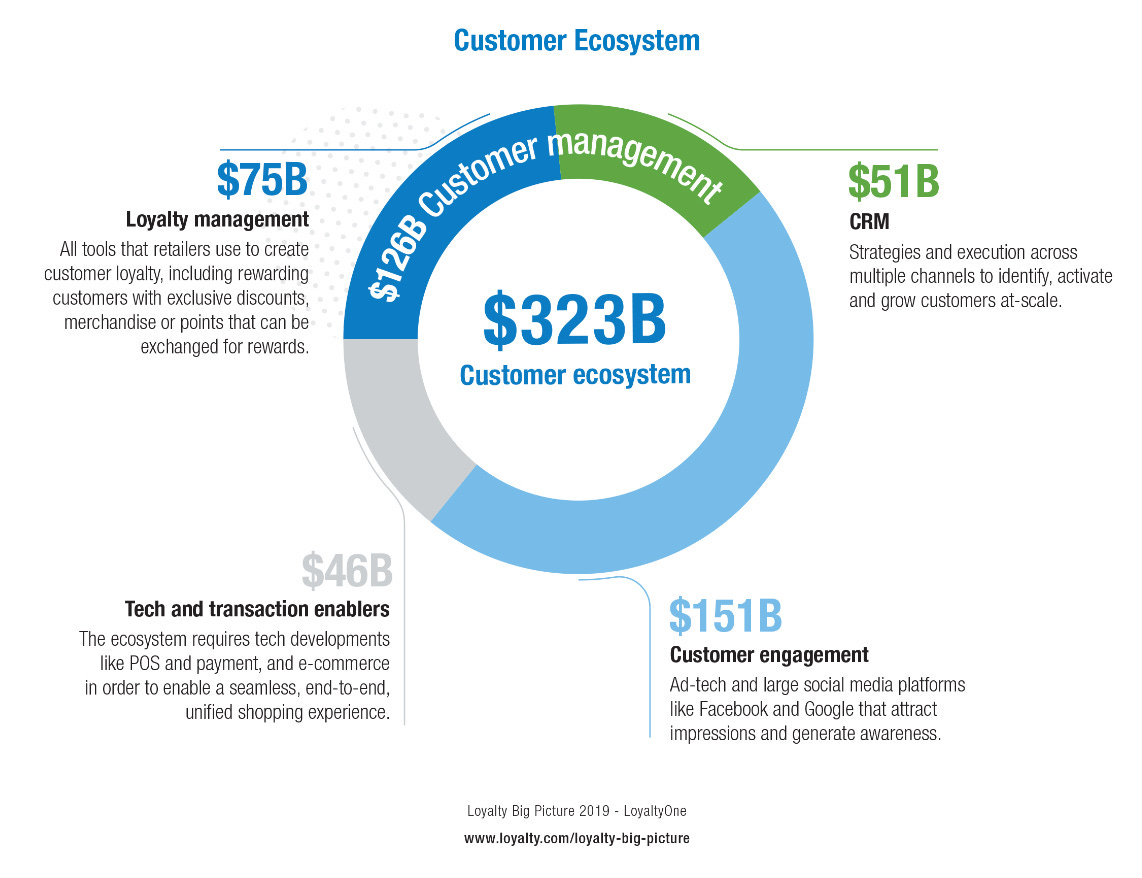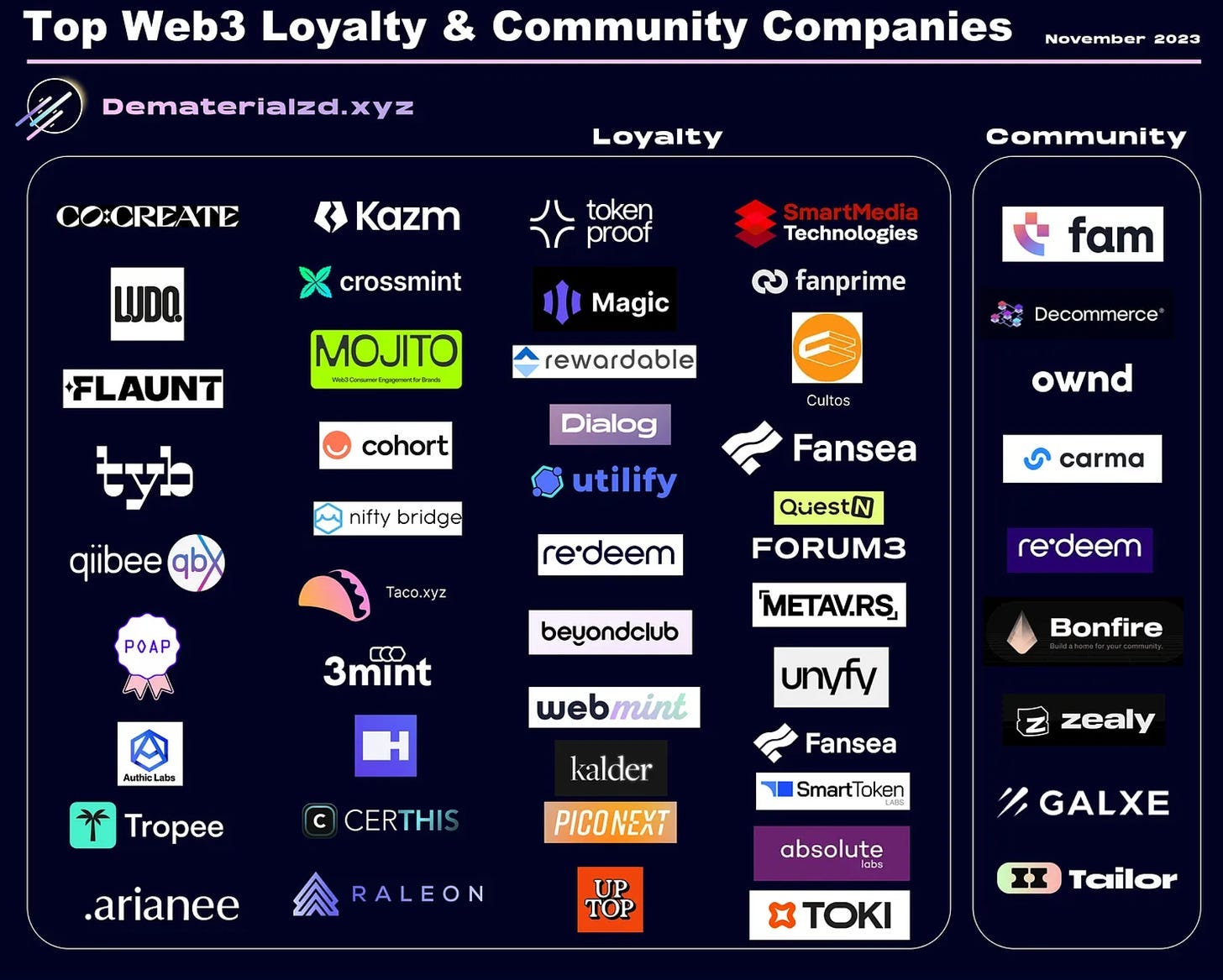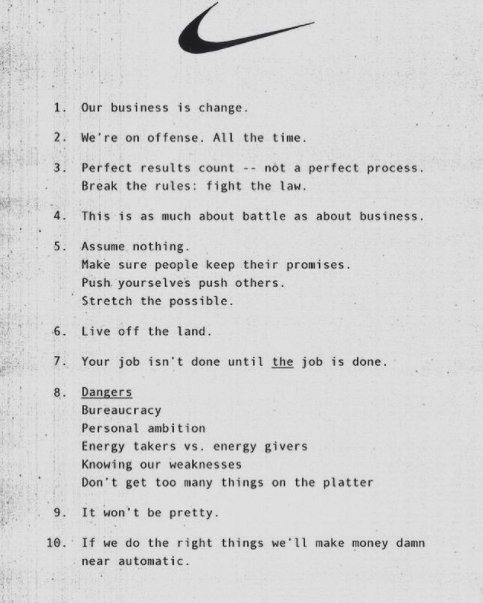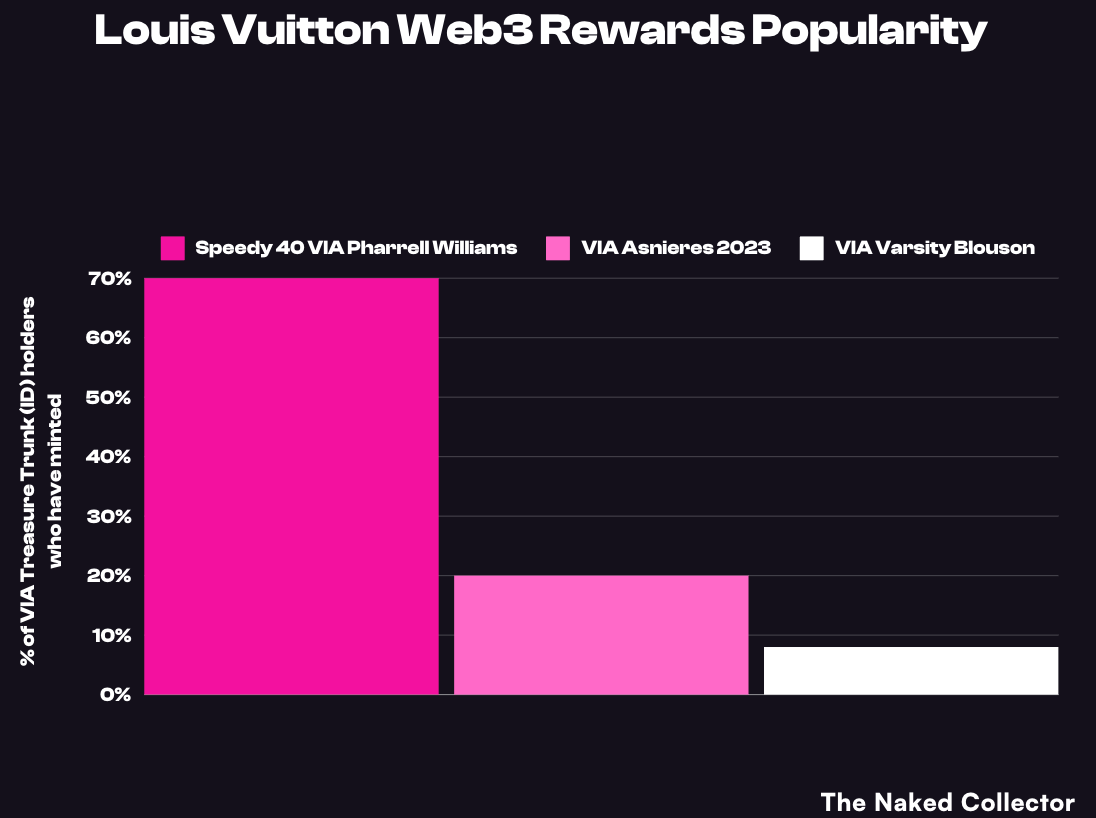Case Study: Web2 Loyalty Sucks. Here's How to Build a Program That Works.
The Definitive Guide to Loyalty Programs: From Traditional Models to Web3 Innovations in 2024 and Beyond
"Some people say give the customers what they want, but that's not my approach. Our job is to figure out what they're going to want before they do."
– Steve Jobs
Staying ahead of customer expectations is crucial in today's fast-paced market, especially for loyalty programs. This article explores how Web3 technology can revolutionize loyalty strategies by anticipating and meeting customer needs innovatively.
Traditional loyalty approaches are becoming inadequate. With the global loyalty management market projected to grow from $6.47 billion in 2023 to $28.65 billion by 2030, companies must rethink their strategies to stay relevant.
Many discussions on Web3 loyalty, including those from traditional consultancies, are superficial, focusing on promises without examining current systems or deeply exploring Web3 strategies. The following three-part series bridges these gaps, addressing both consumer and luxury brands' unique challenges and opportunities.
Designed for industry professionals, marketers, and business leaders, this guide shows how Web3 technology can transform customer engagement and loyalty programs. It offers actionable insights on leveraging cutting-edge technologies to gain a competitive edge in an evolving market.
After extensive research into the loyalty program ecosystem I present this comprehensive guide to Loyalty 2.0 or Web3-powered loyalty programs. Rather than relying on high-level industry overviews or opinion pieces, this guide provides a strategic, in-depth analysis.
Before we start, note that I spent tens of hours researching, querying on-chain data, compiling tables, and creating charts for this report. If you find value in it, please share it with someone who could benefit from these insights.
(Note: To access the "Web2 Brand Loyalty Programs in Web3" report at the end of this deep dive, you need to subscribe to the paid version of this newsletter.)
Let's begin.
1. The Loyalty Landscape
1.1. High Stakes of Customer Loyalty
Why should you care about loyalty programs? Around 90% of all brands use them, and when done right, they can significantly impact revenue and customer retention.
Consider these statistics:
Customer retention is cheaper than acquisition
At the core of loyalty programs is the calculation that customer retention is cheaper than acquisition.
The hype around getting brand loyalty programs just right isn’t surprising, as they directly impact the income statement and shareholder value.
1.2. Traditional Program Challenges
While most loyalty programs are ROI positive, this doesn’t tell the full story:
Poorly designed loyalty programs have led to an increase in inactive memberships.
Given these statistics, it’s no surprise that 65% of companies want to replatform and revamp their loyalty programs.
Current loyalty programs have their origins in the late 19th century with retailers giving stamps for purchases, and the points and tiers systems were introduced in 1981 by American Airlines.
Falling customer engagement may indicate it's time to introduce new mechanisms that make shopping enjoyable for customers and add value for businesses.
1.3. Diverse Loyalty Models
Before we dive deeper into the causes behind poor loyalty programs, let’s take a moment to examine the different types of loyalty programs:
Points: The most popular form of rewards, used by multiple industries including fashion (e.g., $1 spent = 1 point).
Cash Back: Widely used by banks or conglomerates like Rakuten.
Punch Card: While less common now, some businesses like cafes still use them.
Tiered: Common across consumer brands, with rewards increasing at each level.
Partnership: Often used by big companies like Walmart, Starbucks, and Adidas.
Premium: Combines subscriptions and loyalty programs, offering better service and rewards for subscribers.
For your convenience, I’ve summarized the main points in the table below:
Several companies also combine these program types. Adidas, for instance, incorporates loyalty points, loyalty tiers, and partnerships. Fashion brands especially like to combine loyalty points with loyalty tiers (e.g., $1 spent = 1 point in Tier 1, but $1 spent = 2 points in Tier 2).
1.4. Luxury Brand Approaches
Luxury brand loyalty programs are a category of their own. Unlike traditional brands, luxury brands often don’t have official loyalty programs. Instead of using point or tier systems, they focus on VIP customers. These VIP customers receive special surprises, access to exclusive events, and unique in-store experiences.
Typically, loyalty programs are thought of as systems anyone can join to earn rewards. However, in the luxury sector, this isn't the case. To understand luxury loyalty programs, we must recognize that the top 2% of customers contribute to around 40% of their sales. Thus, these programs are designed to reward the top spenders.
Rewards for these customers are usually in the form of gifts. For example, Hermès offers top spenders the opportunity to purchase the highly coveted Birkin or Kelly bags, while Chanel provides gifts and customized in-store experiences.
Rewards for these customers are usually in the form of gifts. For example, Hermès offers top spenders the opportunity to purchase the highly coveted Birkin or Kelly bags, while Chanel provides gifts and customized in-store experiences.
Because discounts can psychologically cheapen products—something luxury brands want to avoid—they increasingly focus on VIP experiences. These include personal relationship management, in-store experiences, and better access to new products, such as Tiffany's Blue Book. Moreover, luxury brands are focusing more on experiential rewards, like Bulgari flying VIPs to Capri for events or providing access to designers and fashion shows.
This experiential-heavy strategy is particularly evident in luxury brand activities in China, one of the most important luxury markets in the world. Chinese consumption is expected to reach 35%-40% of the world's total luxury market by 2030. Luxury brands seem more willing to experiment in China with new technologies and platforms, including NFTs and WeChat. Surprisingly, China was the top country for NFT searches in 2021, and the NFT market in China is predicted to reach 29.52 billion yuan (around $4.4 billion) by 2026.
1.5. Conventional Strategy Weaknesses
Loyalty programs have long been a staple of customer retention strategies, but many are falling short of their intended goals. While there are complex explanations for these shortcomings, such as fragmented loyalty relationships and closed ecosystems, the core issues can be distilled into two main factors:
Rewards are bad – Irrelevant, undesirable, or don't last long enough
Rewards are hard – Too difficult or time consuming to attain
At the heart of these issues lies the quality of the rewards themselves. As we'll see later from the Hermès example, customers are willing to put in almost any level of effort if they deem the reward good enough.
If we were to summarize the current state of loyalty programs in one sentence, it would be this: Unworthy rewards that are too cumbersome to accumulate, that offer unimaginative benefits, and that are too similar to each other.
Unworthy rewards that are too cumbersome to accumulate, that offer unimaginative benefits, and that are too similar to each other.
To put this into perspective, consider that the average customer is part of 16.7 loyalty programs. It's highly doubtful that they'll actively engage with exclusive products or track their access to sneak previews for all of these programs.
Diving deeper into what constitutes “bad rewards” that lead to customer disengagement, we can identify several key issues:
Complexity and Lack of Transparency: Programs with complex rules, tiers, and redemption processes can be confusing and deter participation.
One-Size-Fits-All Approach: Traditional loyalty programs fail to offer personalized experiences, leading to disengagement.
Lack of Emotional Connection: Programs that focus solely on transactional benefits often fail to forge emotional connections with customers.
Restrictive Redemptions: Traditional loyalty programs often have limited redemption options, which can deter customers from participating further.
Devaluation of Points: Brands occasionally restructure their loyalty programs, requiring members to accumulate more points for the same rewards, leading to customer dissatisfaction.
At the core of ineffective loyalty programs is a fundamental misalignment between rewards and customer expectations. Poor value propositions, complex systems, and a lack of personalization and emotional connection all undermine program efficacy. Today's customers are looking for simplicity, relevance, and a deeper connection with brands – elements that many traditional loyalty programs struggle to provide.
By addressing these shortcomings, brands have the opportunity to revitalize their loyalty programs and create more meaningful, engaging experiences for their customers.
2. Web2 Loyalty Program Insights
Before we explore how Web3 can revolutionize the loyalty landscape, it's crucial to understand the current state of loyalty programs. This section will examine successful Web2 loyalty programs, identify their strengths, and highlight areas where even the best programs can improve. By analyzing these elements, we can better appreciate the potential impact of Web3 technologies on customer loyalty strategies.
2.1. Case Study: Sephora Beauty Insider
Success Metrics:
Membership Growth: Over 31 million members in the U.S.
Increased Spending: Members spend 3X more than non-members.
Engagement: Members contribute to 80% of sales.
Business Impact: Contributed significantly to LVMH's (Sephora’s parent company) revenue and profit growth.
Why It Works:
Easy to redeem and access rewards — Seamless integration with Sephora's online platforms and mobile app. Mobile integration of Beauty Talk.
Emotional connection — Sephora focuses on creating emotional connections with customers through emotions like happiness, trust, surprise, delight, and pride.
Emphasize emotional rewards over mere discounts.
Members can redeem points to make donations to featured charities. This connects the program to members' values and emotions.
Multi-tier system (Insider, VIB, Rouge) encouraging higher spending.¨
Research has found that almost 75% of what drives customer engagement and loyalty are emotional perks.
Community-building: Beauty Insider Community is a real-time social forum for customers to ask questions, share beauty looks, and get product recommendations. 5.5M+ members have generated 2.7M+ posts. This also allows Sephora to integrate community insights into product development and marketing. Community ambassadors and active staff participation.
Relevant rewards: The loyalty program provides a community and rewards tailored to their interests. The program offers tailored experiences such as beauty classes, exclusive events, and unique product sets.
Flexibility of rewards: Rewards Bazaar is an exchange platform where members can redeem points for a wide range of curated products and sets. New products are constantly added. Thus, points can be redeemed for a wide range of rewards, allowing customers to choose what they value most.
2.2. Case Study: adiClub
Success Metrics:
Over 250 million members globally, making it one of the largest loyalty programs in the sportswear industry.
Adidas adiClub members buy 50% more often than non-members.
Adidas adiClub members' lifetime value is double that of non-members.
Why It Works
Wide availability: The adiClub membership program is now established in around 50 countries and linked seamlessly to digital and physical channels.
Emotional connection: The program offers unique experiences such as training with professional athletes and VIP access to major sporting events like the UEFA Champions League Final. These are experiences that are hard to find in other loyalty programs. Also, campaigns like "Run for the Oceans," where members' activities contribute to environmental clean-up efforts, demonstrate a strong commitment to social and environmental causes, adding a meaningful dimension to the program.
Gamified Profiling: adiClub’s use of gamification in profiling and reviews, where members influence product designs and participate in challenges, keeps engagement high and makes the program interactive and fun.
Non-Transactional Engagement: Members earn points not only through purchases but significantly through their physical activities tracked via Adidas Running and Training apps. Members receive 10 points for completing their daily workout and 3 points for every mile they run. Participating in an Adidas Runners event is worth 100 points. Moreover, the program encourages engagement through non-transactional means such as profile completion, reviews, and social media interactions, making it more than just a points-for-purchases scheme.
Exclusive and Limited-Edition Products: Members have access to rare sneaker releases and special collaborative collections, creating a sense of exclusivity and excitement.
2.3. Case Study: Rakuten Points
Success Metrics:
111 million+ members, covering 80% of Japan's population.
3 trillion Rakuten Points issued.
Regularly ranked as Japan’s top loyalty points program for customer satisfaction.
Why It Works:
Ease of Use and User Flexibility: Simple to earn and spend points across 70+ Rakuten services and 49,000 stores via Rakuten Ichiba platform. Allowing customers to choose how to spend their points enhances engagement and satisfaction.
Innovative Features and Continuous Innovation: Users can invest their Rakuten Points in the stock market since 2018 and exchange points for cryptocurrency free of charge since 2021. Adapting to market trends, such as enabling cryptocurrency investments, keeps the program relevant and appealing.
Interoperability:Functions similarly to Web3 platforms by integrating multiple services and enabling easy point utilization.
Allow the customer to choose what they want to spend points on
2.4. Loyalty Evolution Opportunities
While the case studies above demonstrate significant successes in Web2 loyalty programs, it's important to recognize that even these industry leaders face challenges. As we move towards Loyalty 2.0, we need to look beyond simple KPIs like LTV-CAC and transactional rewards that have dominated the landscape for over 40 years.
Consumer feedback, particularly on social media platforms like Reddit, reveals ongoing frustrations with loyalty programs. These sentiments, combined with previously mentioned statistics, suggest that many consumers perceive loyalty programs as primarily benefiting companies rather than customers.
2.5. Takeaways from Successful Web2 Loyalty Programs
After analyzing the statistics, case studies, and user feedback, we can identify several key elements that successful programs have in common:
The rewards are relevant
Personalized – Users get a say in what they want to redeem their loyalty for
Redeemable – There have to be relevant products/experiences/services to spend the points on. Too frequent devaluation of points causes frustration in customers.
Meaningful – The rewards feel meaningful and give an air of exclusivity instead of outlet vibes (79% of customers said being able to unlock exclusive benefits made them loyal)
The program is simple to use
The program is integrated seamlessly across physical and digital channels
Emotional connection to the brand should be at the core (not discounts)
Experiential rewards – Deepens the psychological bond between brand and customer and emotional perks are what drives customer engagement and loyalty.
Community – Creates a moat and a testing ground for brand
Incorporating these elements will allow brands to build not only a successful loyalty program but create positive brand associations which drive other substantive metrics such as referrals, stock price, valuation, and higher profitability.
In the next sections, we will explore how companies can find meaningful rewards for customers and why emotion is crucial in loyalty programs. As we'll see, the transition to Web3 technologies offers exciting possibilities to address current limitations and take customer loyalty to new heights.
Emotion = Everything
3. Web3 Loyalty Revolution
Just because something has been done for years doesn’t mean it works.
Culture is no longer created top-down by brands; the focus has shifted to grassroots and user-generated content. From identical Gen Z and Alpha gym outfits to TikTok trend-driven merch — so why is most consumer-brand relationship management still top-down?
Is it a coincidence that the brands with the “best” Web2 loyalty programs such as Adidas, Nike, Starbucks, and Hugo Boss are actively looking to Web3?
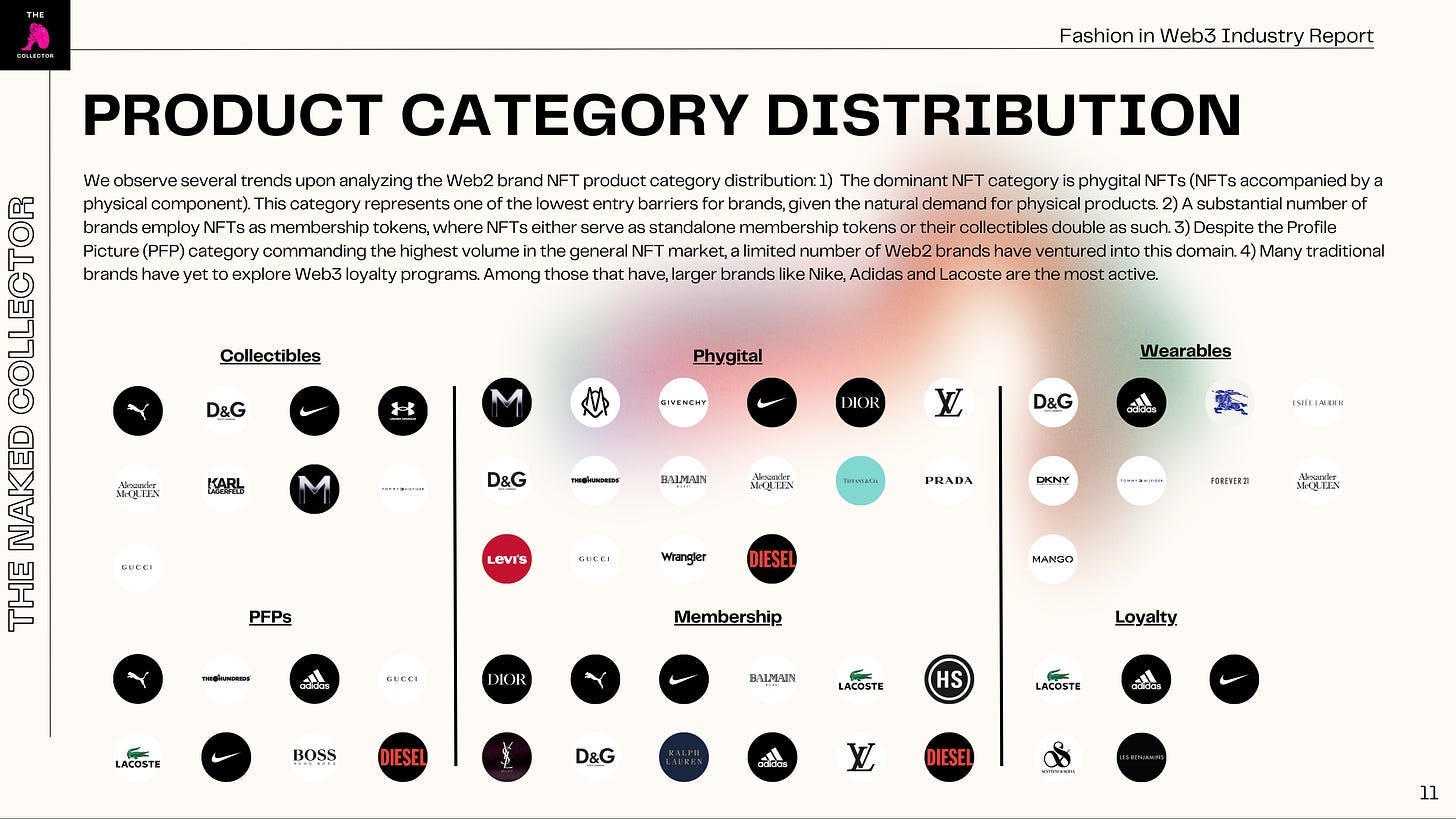
It’s still early, and despite multiple attempts, no traditional brand has cracked Web3 loyalty yet.
To be successful, brands need to understand:
What NFTs and fungible tokens are and what they’re not.
How Web3 can enable relevant rewards, simplicity and drive emotional connection.
How Web3 should be implemented.
This deep dive will help you uncover these insights.
3.1. Understanding Web3 Loyalty
Simply, Web3 loyalty incorporates public blockchain technology in some way using fungible (e.g. ERC-20) or non-fungible tokens (NFTs).
3.1.1. Three Types of Tokens Can Be Used
In Web3 loyalty programs, three types of tokens can be used:
Transferable NFTs
Description: NFTs that can be transferred from one wallet to another.
Use case: Unique rewards, links to physical items, tradable memberships, PFP collections
Examples: Lacoste – UNDW3
Soulbound NFTs
Description: NFTs that can be transferred from one wallet to another.
Use case: Membership IDs
Examples: Louis Vuitton VIA Treasure Trunk
Fungible Tokens
Description: Crypto tokens that aren’t unique from one another. Can also mean loyalty points that can be converted to crypto.
Use case: Transferrable points
Examples: ApeCoin, Rakuten
3.1.2. NFTs Are Not Just Exclusive Digital Products
NFTs (Non-Fungible Tokens) are unique digital assets verified using blockchain technology. Unlike cryptocurrencies, which are identical to each other, NFTs have unique properties and can represent a wide range of items, from digital art to loyalty points.
However, NFTs are not just digital rewards.
Even BCG reports seems to confuse NFTs, the technology, with NFT, the digital product. To understand its full potential it’s important to identify what NFTs are correctly.
Unlike what the BCG graphic (and other above would let you believe, NFTs are not just digital products or rewards. Instead, NFTs can be the:
Membership IDs
Digital-only products (e.g. generative art piece)
Rights to real-world products, services and experiences
NFT can be redeemed for or connected to the physical
NFT can be the ticket to an exclusive event
NFT can be the access token to other members
Because of the limiting belief that NFTs are just digital rewards, many traditional brands seem to use them only as such, not fulfilling their full Web3 potential.
NFTs can take the form of IDs and products, but products can also take the form of IDs or access tokens.
This property is one of the zero-to-one innovations of Web3.
In theory you could infinitely segment your members by the NFT metadata linked to the products. Each segment could get access to different (or partially different) products and community channels.
Here’s an illustration of what that could look like:
Instead of having regular Web2 community channels (e.g. Sephora Beauty Insider), you could have additional exclusive channels that are only accessible to e.g. “Black-Gold” token holders. Combining such dynamic interest graphs with exclusivity could be a big unlock for brands and consumers.
In practice, these sub-communities could receive NFTs and/or have their wallets allow-listed for unique rewards based on their product/NFT holdings. The memberships would create an element of surprise, foster social interaction, introduce gamification, and enable truly 1-of-1 discounts.
Moreover, if NFT metadata is linked to products, brands could find which products are most popular in real time.
UNLOCK: Instead of having three membership tiers, you can microsegment your members as granularly as you want.
What Adidas is doing with ALTS by Adidas NFTs, is somewhat similar to this. Each ALTS by Adidas NFT has a distinct metadata identity which in turn is linked to unique rewards and product discounts.
3.1.3. Loyalty NFTs vs NFT Projects
The lack of distinction of NFT communities (e.g. PFP projects) and loyalty programs is what has led to the poor price performance development of several NFT collections.
Based on this framework, RTFKT started out as an NFT community but transitioned to a loyalty program (e.g. RTFKT x Nike Lace Engine gave a 20% discount on Cryptokicks IRL). Whether the project will recover depends on its ability to become an NFT Project again. (I cover what happened to RTFKT in more detail here.)
ALTS by Adidas ran into the same problem as RTFKT as it transitioned from its Into the Metaverse NFT collection to ALTS by Adidas.
On the other hand, many Web2 brands like Gucci never really became true NFT Projects.
However, NFT Projects can have Loyalty Program-type benefits (e.g. LinksDAO) and Loyalty Programs can create communities that become NFT Projects.
With that out of the way, we’re ready to move on to the discussion of how Web3 can supercharge Web2 loyalty programs.
3.2. Web3 Loyalty Transformations
As discussed, the are the successful components of any loyalty program:
Its rewards are relevant
It’s simple to use
It creates an emotional connection
3.2.1. Web3 Enables Hyper-Personalization
Users get a say in what they want to redeem their loyalty for.
Hyper-targeted two-way communication can increase conversion rates and improve loyalty. As I discussed in Part 3 of my LVMH case study:
In essence, Web3 wallets allow brands to know their customers better due to improved behavior (yet privacy-preserving) tracking. Brands no longer have to guess what their customers will appreciate. NFT wallets give insights into customer preferences. Currently, brands know very little about a customer. Web3 wallet content is good for indicating what kind of rewards are relevant for user (and which brands should you collaborate with).
For instance, looking on the blockchain I can see that of the 10,375 unique wallet holding ALTS by Adidas, 1440 hold ApeCoin fungible tokens, 1233 hold Art Blocks NFTs, 1155 hold Otherdeed Expanded NFTs.
This could indicate that collaboration with BAYC ecosystem or Art Blocks could be well received.
Importantly, Web3 introduces new KPIs like 'fandom' that are difficult to measure with previous technologies. Fandom could be measured by in-store logins, Web3 wallet content and dynamic product graphs (discussed earlier) or the number of times a brand product has been worn (e.g., logging in using the NFC chip from the brand shirt).
This two-way communication unlock is further needed due to the cookie-less direction we’re headed towards. In BCG’s words: “As brands peer into a cookie-less future, they are eager to construct their own loyalty programs for first-party data collection to better engage customers—a function that Web3 serves with broad versatility.” Even Google has started to block tracking cookies, which will make ad targeting based on online more difficult for brands.
UNLOCK: Web3 can introduce new KPIs like 'fandom' in areas that were difficult to measure with previous technologies.
On the other hand, Web3 wallets can be targeted without affecting their everyday UX. Having the Web3 wallet as the targeting interface, lets users, not brands, decide when they want to see promotions (e.g. connect wallet to unlock promotions).
While tracking has justifiably received a bad rap, all tracking isn’t bad. Spotify recommends tailored playlist and Spotify Wrapped gives users a delightful glimpse into their behavior. Done in the right privacy-preserving way it can be a win-win for both the brand and the customer.
After all, people like to find they’re in the top 1% of something whether that’s listening a song, wearing a shirt or completing a challenge.
3.2.2. Web3 Enhances Usability and Redemption
There have to be relevant products/experiences/services to spend the points on. Too frequent devaluation of points causes frustration in customers.
In traditional Web2 systems, customer loyalty points are siloed in private databases, leading to frustration due to frequent devaluation and lack of relevant redemption options. Web3 addresses these issues by making points transparent and tradable on the blockchain. NFTs or fungible points allow loyalty program rewards to become tradable not only within the brand ecosystem but across ecosystems.
Web3 creates an open economy for loyalty rewards within brand ecosystems, improving redeemability in several ways. A useless reward for one customer could be treasured by another, and the ability to resell rewards introduces cash back features to points-based programs. This system benefits customers who don't frequently shop with the loyalty program or don't care about traditional rewards, effectively offering cashback for some and tier-based benefits for others, while expanding earning opportunities across all loyalty programs.
UNLOCK: Web3 enables loyalty programs to be tier-based for some, points-based for others, and cashback-based for yet others.
Web3 also enables an open economy for loyalty rewards across brand ecosystems. Cross-brand partnerships become easier, allowing customers to redeem or exchange loyalty rewards across brands (e.g., Delta to Starbucks) without the need for one-to-one partnership programs. This approach eliminates costly partnership negotiations. As BCG notes, traditional "connected loyalty" partnerships struggle to scale beyond one-to-one setups. Web3 solves this by allowing brands to grant access to their loyalty ecosystem on the fly. For instance, Starbucks NFTs could provide token-gated access to Delta Airlines rewards, enabling effortless partnership scaling. Brands can still maintain some control by creating their own marketplaces with allowlisted NFTs (e.g., Starbucks NFTs on Delta platform). While ultimately due to the open nature of Web3 customers can use points as they wish, they may need to take additional steps like exporting wallets, making it easier to redeem preferred partner reward.
Instead of companies valuing points, customers would do so in real-time within or across brand ecosystems.
This means expanded earning opportunities for members across all loyalty programs.
UNLOCK: Web3 gets rid of costly partnership negotiations.
The concept of tradable loyalty points aligns well with younger demographics familiar with in-game currencies, suggesting a natural adoption pathway.
3.2.3. Web3 Elevates Reward Meaningfulness
The rewards feel meaningful and give an air of exclusivity instead of outlet vibes.
While personalization and redeemability affect the meaningfulness of rewards, true meaningfulness also requires authenticity. Are you actually giving customers something of value? Remember, value doesn’t have to be measured in dollars.
If you claim a reward is exclusive, prove it. If brands say it's a deal, it should actually be one. Customers are savvy and will see through corporate jargon. Any hint that brands trying to take advantage of them will result in bitter online forum posts.
The transparent nature of Web3 allows brands to offer real, verifiable exclusivity instead of mere promotional exclusivity.
“…I feel like we need to go back to gatekeeping. Everyone is sharing way too much information. We’ve all worked hard to find places and a distinct style, and I don’t think it should be given out on the internet all the time.”
– Laura Harrier
Instead of focusing on discounts for products customers don’t want or community basketball game activations 9,000 km (5,592 miles) away (looking at you, Nike), Web3 can involve the community in a meaningful and scalable way.
We must remember that Gen Z resonates with genuine brands that engage in two-way conversations.
These are some specific Web3-enabled elements that can lead to meaningful rewards:
Customizable NFT Identity Badges: Uniquely randomized traits create a connection to the brand, with different utilities based on traits.
Co-creation of Products and Rewards: Decentralized governance allows for collective decision-making and enhances transparency in loyalty programs.
Rewarding Unique Behavior: Instead of an arbitrary 10% discount, customers receive discounts for meaningful contributions, such as co-creating a new sneaker.
Unique Art NFTs for Loyalty Tiers: Each season could feature new artists for tier NFTs, adding a collectible aspect.
Complete Ownership and Control Timeless inscriptions on the blockchain gives customers a greater sense of ownership over their rewards.
Tradeable Rewards: If rewards are indeed meaningful then brands should have no qualms about letting the market decide their value. This also acts as a great feedback mechanism for brands.
Social Impact Initiatives: Studies have found that value-based rands are is especially important for Gen Z. Verifiable carbon footprint offsetting using Web3 platforms like KlimaDAO could be used.
Meaningful participation by existing customers in the brand's story via ownership creates organic desire from new customers. These organic brand ambassadors could revolutionize customer acquisition.
At their core, customers want to participate in the brand story, feel empowered by the brand, and have a way to signal this.
3.2.4. Web3 Fosters Stronger Emotional Connections
Emotional connection to the brand should be at the core
One of the biggest takeaway from Antavo’s Global Customer Loyalty Report 2024, is something we all already knew, emotional connection to the customer is important.
One of the bet ways to create an emotional connection is through unique experiences and gamification. Gamification elicits emotions, boosts recall, and enhances engagement. Gamified referral marketing programs have a 3-5x higher conversion rate than non-gamified ones.
These are some of the most proven and alluring gamification elements in Web3:
Randomized traits
Financial upside
Digital status and exclusivity
Digital to physical connection
Before jumping into Roblox gaming, which has its drawbacks, brands need to remember that gamification doesn’t need to be tied directly to games or digital experiences. Decentraland’s low user statistics show that merely combining a brand and a game doesn’t guarantee success.
Web2 gamification efforts in Web3 often feel forced. Uninspiring quests like hashtag challenges may create short-term results but aren’t viable long-term.
More interesting ventures are metagames, or games about games.
Some of the most immersive metagames are:
Status → Luxury and class
Wealth → Forbes Richest list
Academics → University rankings system
Stock market → Stock prices and market caps
Venture capital → Money-on-money multiple, lead investments, cap tables, thought leadership
The more brands can create these metagames the more interesting its ecosystem becomes.
For a game to be interesting, it must meet certain conditions:
If a player doesn’t have autonomy, the game is rigged.
If a player doesn’t have control, the game is boring.
If a player cannot display their results, the game is meaningless.
Web3 creates conditions for these to exist in ways that Web2 cannot:
Autonomy of decision:
In Web2 loyalty programs, users can only redeem points for specific rewards chosen by the company. Terms and conditions can be changed without user consent, often leading to point devaluation or expiration. In contrast, Web3 enhances user autonomy significantly, allowing users to use points across various platforms or convert them into other digital assets freely. Immutable rules enforced by smart contracts ensure transparency and unchangeable conditions. Web3 allows users to use points as they see fit, such as exchanging points or NFTs for other rewards not chosen by the brand.
Control of experience:
In Web2 loyalty programs, users cannot influence how points are earned or redeemed and must follow rigid program rules. The processes involved are typically opaque, making it hard for users to understand their progress. Web3, however, provides more control to users, enabling them to participate in governance decisions and influence how points are earned and used. All rules and transactions are recorded on a public blockchain, making processes transparent. Web3 allows users to affect rules through governance, such as choosing rewards.
Display of achievement:
In Web2 loyalty programs, the display of points is managed privately, with ownership and authenticity controlled internally by the company and no external verification possible. Web3 systems offer public verifiability, as ownership and authenticity of points are recorded on the blockchain, allowing for independent verification. Web3 also allows for cross-ecosystem status display, similar to how CryptoPunks, BAYC, and Pudgy Penguins owners receive preferential treatment in other Web3 communities. Web3 allows users to display their achievements, such as holding a rare NFT that is verifiably theirs.
I cannot advise on how your brand-specific metagame should look, as it will vary depending on whether you’re Nike, a Web3 startup, a luxury brand, or another consumer brand.
However, here are some metagames I’ve covered before:
In sum, Web3 wallets enable brands to offer more dynamic, experiential rewards beyond just discounts or points. Customers can earn unique digital collectibles, access exclusive content/experiences, and participate in brand communities – fostering deeper engagement.
At the core of these loyalty programs (Web3 or not) should focus around personalization, redeemability, meaningfulness and emotional connection.
3.3. Web3 Luxury Loyalty
Luxury brands face unique challenges that regular brands do not, including:
Discounts cheapen their brand
Long product creation cycles
Top 2% of luxury customers contribute to around 40% of their sales
High churn rates among first-time buyers
To combat these, luxury brands often focus on VIP and VVIP programs instead of traditional loyalty programs, rewarding top customers with gifts and experiential rewards to maintain exclusivity.
NFTs can enhance luxury “loyalty” programs in three main ways:
NFTs Are Ecosystem Keys That Give Access to Personalization and Token-gated Experiences
The authentic properties and apps allow NFTs to act as badges
This enables seamless cross-brand programs
Experiences can be physical or virtual
Immersive physical spaces combined with digital activations are the future of luxury commerce as seen with Gentle Monster, a luxury eyewear brand growing fast in China. Token-gated NFT access can enhance these environments.
NFTs Represent Exclusive Standalone Rewards
While traditional luxury items like Hermès Birkin bags are compelling, tokenized assets offer convenience and new opportunities for exclusivity. The Hermès Birkin bag launched 35 years ago and the supply is constantly increasing. Birkin (and other) fatigue could hit at some point. For those treating these bags as investments, tokenized assets would be a significant improvement.
New generations value digital assets as status symbols, which can lower the threshold for receiving rewards and reduce the fear of diluted supply. Incremental non-physical rewards could lower the threshold for customers to receive loyalty rewards, making them more appealing, while reducing the fear of diluted supply for brands.
New immersive technologies will require brands to have status-displaying items in those realms as well. Just like IRL discounts, discounts or even free brand assets in immersive environments could cheapen the brand, while digital-only (non-NFT) assets wouldn’t make sense due to lack of real ownership, transparent provenance, and a secondary market.
Geographical reward segmentation will be easier than ever.
Based on proprietary on-chain data gathered, almost 17,000 unique NFT collections have exceeded $200,000 in secondary sales or mint volume per month at some point since 2021, indicating strong and growing demand for digital assets. As of July 10, 2024, there are also 74,242 millionaire wallets ($1M+ in assets on Ethereum).
NFTs Enable Dual VIP Programs
NFTs enable luxury brands to have dual VIP programs—one for the top 5% and another for higher-churning lower-spend consumers.
NFT rarity tiers, inspired by collections like VeeFriends, can add exclusivity. If access NFTs start reselling at high premiums, this could render the VIP Program even more desirable to outsiders.
NFTs authenticate exclusive physical art pieces
NFTs can authenticate exclusive physical art pieces inspired by digital art, integrating emerging subcultures and artists
Ultra-exclusive collaborations with digital artists (e.g. Dmitri Cherniak, Tyler Hobbs, Xcopy) can create high-demand assets outside of main product lines (trading volume since 2021 for Art Blocks NFTs is $1.8B). Such collaborations would make for excellent 1 of X collectors items for loyal customers.
Brand heritage can be enhanced by digital assets.
The above properties are in addition to the general tokenization benefits of high-value assets, such as enhanced authentication and product lifecycle management. Tokenization improves product repairs and provides more transparent condition reports for the secondary market. While not directly tied to loyalty, products that are repairable, collateralizable, and resellable may help retain high churn first-time buyers.
3.4. Web2 Giants Adopting Web3
To understand what Web2 brands are doing in Web3 loyalty, here are key Web2 brand loyalty programs in Web3. Premium (paid) subscribers to The Naked Collector will also get access to a detailed 42-page report at the end of this post, covering each Web2 company's Web3 loyalty program.
(Click on the image to open Google Sheets for better quality).
The Web3 loyalty landscape is diverse and experimental, featuring a mix of large brands and niche players. Here's a high-level analysis:
Innovation and Engagement:
Gamification and Dynamic NFTs: Several programs, like the recently announced Hugo Boss XP and ALTS by Adidas, use dynamic NFTs and gamified elements to enhance engagement.
Digital-Physical Integration: Programs like Starbucks Odyssey and UNDW3 link digital rewards with physical experiences, enriching customer interactions.
Market Response:
User Fatigue and Challenges: Some initiatives, like VIA and Starbucks Odyssey, face user fatigue and technical challenges, impacting participation and retention rates. Just 7% of VIA Treasure Trunk (Louis Vuitton Web3 ID) holders redeemed the latest release, based on on-chain data.
Varying Success: Programs have mixed success, with some like Uptrip seeing high engagement, while others like ALTS by Adidas witness declining interest.
Technological Adoption:
Blockchain Diversity: Various blockchains are used, with Polygon being prominent. Programs also experiment with non—Ethereum and Polygon solutions like X Layer and Aura.
NFC and Soulbound NFTs: Innovative tech like NFC integration in Hugo Boss XP and soulbound NFTs in VIA highlight unique approaches, though they sometimes limit tradability and broader engagement.
Strategic Positioning:
Brand Integration: Programs often integrate or complement existing loyalty schemes, enhancing their appeal (e.g., Starbucks Odyssey with Starbucks Rewards).
Long-term Commitment: Programs like dotSWOOSH show long-term potential, while others appear more like temporary experiments.
Overall Trends:
Focus on Co-creation: Brands like Adidas and Nike emphasize co-creation, engaging users in product development.
Expansion and Adaptation: Many programs are still in early stages with plans for global expansion and further integration, adapting to user feedback and technological advancements.
Overall, the Web3 loyalty landscape is marked by innovation, technological diversity, and varying degrees of market success, with a clear trend towards integrating digital rewards with physical experiences and existing loyalty programs.
3.5. Web3 Loyalty Benefits Overview
To summarize the unique Web3 advantages, here’s a cheat sheet.
3.6. Web3 Loyalty Paradigm Shift
Most Web3 loyalty coverage of Web3 loyalty still doesn’t get the big picture. The advantage of Web3 isn’t just the $75B+ rewards industry (think loyalty management in the visual below). It’s the entire pie: Loyalty management, tech and CRM, customer engagement and tech and transaction enablers.
As I mentioned previously, NFTs are not just rewards visualized in my Fashion in Web3 Industry Report Web3 has implications for the entire customer ecosystem stack.
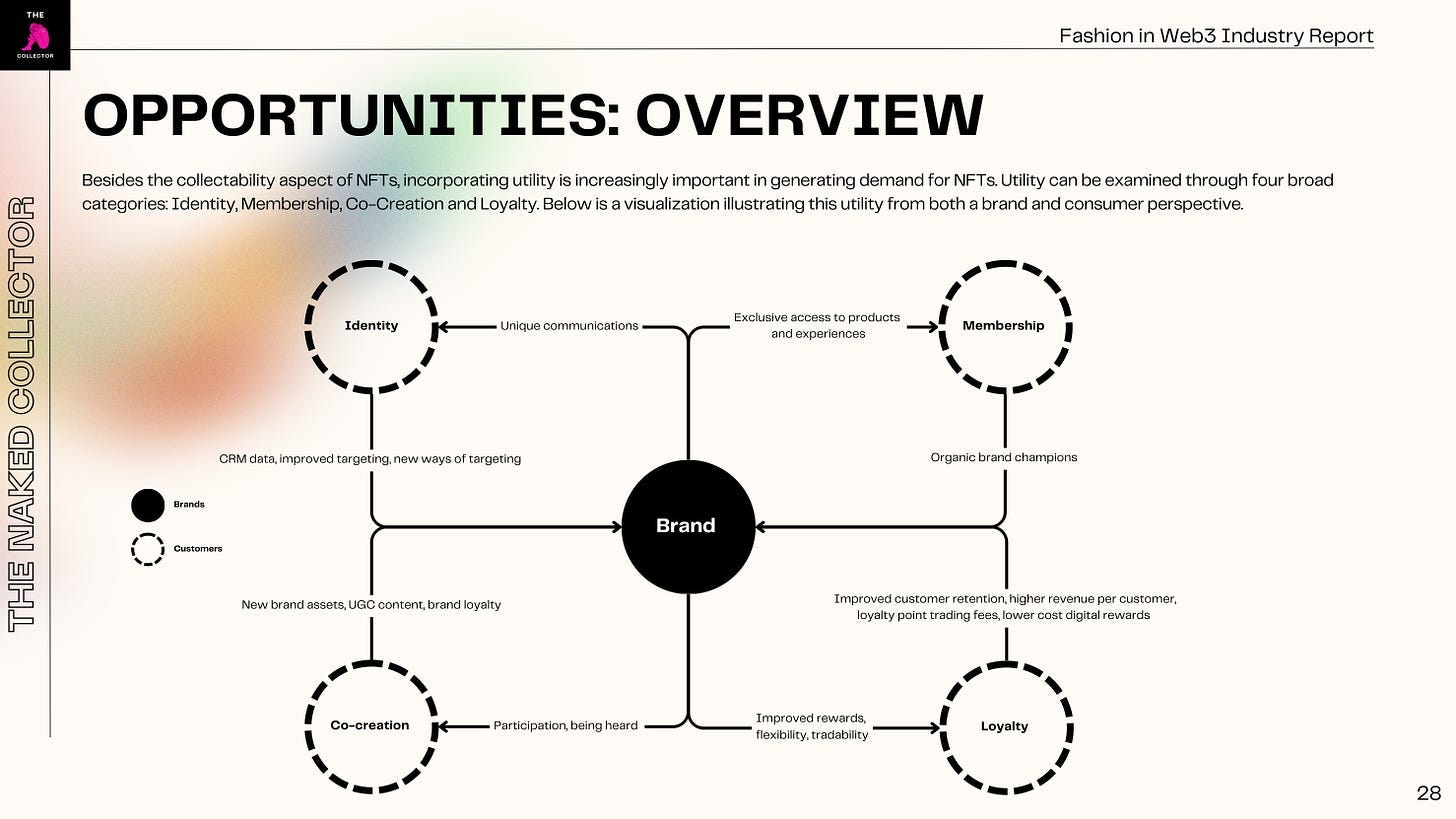
4. Crafting Successful Web3 Loyalty Programs
4.1. Defining Your “Why”
Entering Web3 as a brand can be challenging. Different communities vie for your attention and even offer incentives to build on their tech stack. However, choosing the right tools isn’t always straightforward. Below are just a few Web3 loyalty/community tools, but they barely scratch the surface.
Despite what people or projects tell you, it's not about the specific tools you use. Multiple projects can achieve the same results. It's about how you use the tools.
From a tech perspective, onboarding people into Web3 is no longer that difficult. Nearly 400,000 dotSWOOSH NFTs have been minted, and Pudgy Penguins have linked Web3 wallets to Walmart toys.
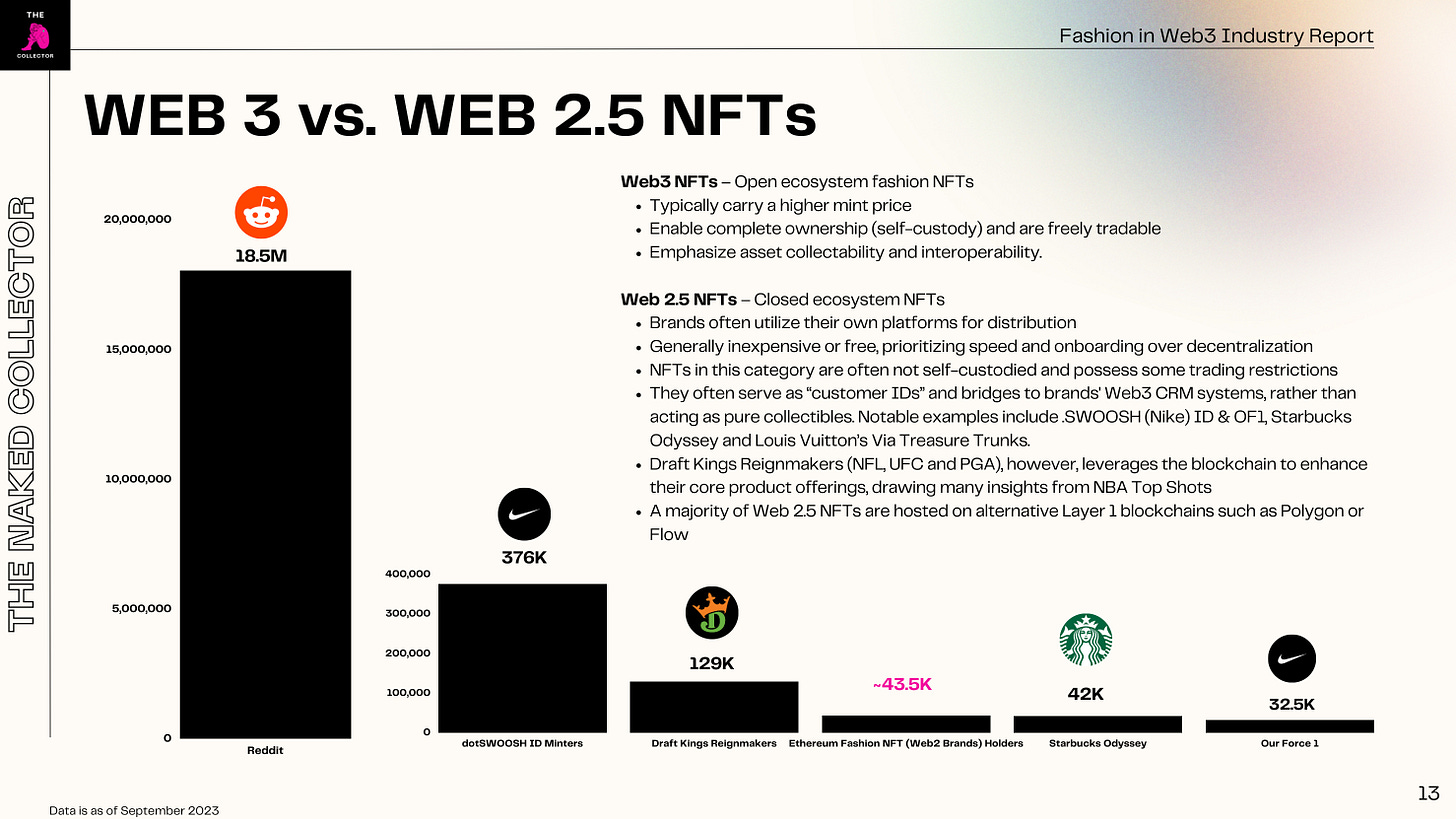
It’s not about the tools. It’s about the “why”.
Several big brands have failed despite receiving all possible help and millions in funding.
The difference lies in strategic vision and alignment with the brand’s “why.” Simon Sinek’s book “Start With Why” explains this well.
Simon Sinek's Golden Circle framework includes three concentric circles: "Why" (core purpose and motivation), "How" (unique methods and values), and "What" (tangible products and services). Inspirational leaders start with "Why," then move to "How," and finally "What." Most organizations typically start with "What" and move outward, leading to failure.
Examples of “whys” for various companies:
Many companies have lost their “why”. We see this with several luxury brands that have forgotten their roots and run predictable strategies. Gucci is a prime example.
Nike is also experiencing this. They posted their first digital sales decline in almost a decade, while challengers like On and Hoka have posted record numbers. Nike hasn’t felt innovative in recent years, relying on unimaginative versions of old models (perhaps their new AI designed sneakers is the change they needed). They need to focus on product innovation, but with a market flooded with high-performance sneakers, physical products alone won’t drive growth. Nike’s advantage over companies like Hoka and On is their ecosystem. Web3 can plug customers into this ecosystem more closely than physical products or SNKRS drops ever will.
Is Nike’s Web3 strategy fulfilling Nike’s “why”? It remains to be seen. While they have innovated, they haven’t focused on their core market—the athlete. For example, they could create official Nike basketball courts where participation NFTs can be claimed using the NFC chip on a Nike shirt. Something new and exciting.
The controversy with RTFKT arose because they deviated from their “why”. Originally an NFT project, they transitioned to a loyalty program model after the Nike acquisition. This incongruity caused the community to lose trust, leading to a sharp drop in RTFKT asset prices despite strong fundamentals.
It’s not about the tools you use, the influencers or partnerships. It’s not even the funding you receive. It’s about knowing what the technology can do for you and aligning that with your vision.
This is the exact reason why most Web2 brand projects have failed to gain traction in the Web3 space (I’ve listed them here).
Conversely, brands like Hermès are clear about their “why”, reflected in their positive financial results via their traditional business.
It’s not coincidental that one of the first things Bernard Arnault did after acquiring Boussac (parent company of Dior) was to refocus on its crown jewel, Dior, even if that meant firing 9,000 Boussac workers.
I see continuous misalignment between companies entering Web3 and their “why”. People notice when companies rush to capitalize on new trends. Only a fraction of the brands that entered Web3 are still active in the space.
Ultimately, a successful loyalty program in Web3 hinges on a clear alignment with the brand's core purpose and values, ensuring that every strategic move resonates with the fundamental "why".
4.2. Implementation Strategies
Although several big brands have created internal Web3 task forces, their Web3 initiatives often come out subpar due to the Web3 knowledge gap or company bureaucracy.
It's crucial to ask the right questions and not just rely on peer initiatives that may be outdated by the time you launch yours.
Here are some things you as a brand should keep in mind:
4.2.1. Selecting the Right NFT Type
There are essentially two options:
Transferrable
Non-transferrable (soulbound)
For those interested in exploring the design space further, I’ve compiled an NFT standards list here.
Although, generally, NFTs should be tradable and exist on established public blockchains, loyalty/membership IDs can be soulbound or non-transferrable.
4.2.2. Understanding and Enhancing NFT Value
Brands must respect their customers and maintain consistent communication. They cannot launch their collection as utility NFTs and later change them to collectible NFTs (as seen in RTFKT’s case). This inconsistency will not be well-received by holders.
Below is a rough guide to what makes NFTs valuable:
4.2.3. Identifying Key Performance Indicators
Here are three simple KPIs to track:
Loyal Holders %: For example, querying the blockchain shows that 19% of users who minted (received) the Lacoste NFT loyalty pass (UNDW3 Card) are still holding it.
Average Price or Reward Popularity: While some don’t like floor price and average price discussions, these metrics provide insight into the desirability of an NFT collection. Examining price trends over time indicates whether rewards are valued by your customers (or other users). This offers real-time feedback on which rewards work and which don’t.
Reward Redemption: How many of your loyalty or membership program holders are redeeming rewards? For instance, a study of the Louis Vuitton VIA program reveals decreasing redemptions by members. This may suggest an opportunity to enhance the utility of rewards, adjust prices, or explore alternative designs to better meet customer preferences.
5. The Future of Loyalty
The evolution of loyalty programs is critical as traditional methods become increasingly inadequate. With the global loyalty management market projected to grow from $6.47 billion in 2023 to $28.65 billion by 2030, businesses must innovate to stay ahead.
Web3 technology offers transformative potential for loyalty programs, providing enhanced user autonomy, transparent transactions, and verifiable achievements. These features not only meet but anticipate customer needs, fostering deeper engagement and loyalty.
Web3 enables customers to influence program rules, customize rewards, and trade loyalty points across ecosystems, ensuring that rewards remain relevant and valuable. This level of personalization and control aligns perfectly with the expectations of modern consumers, particularly Gen Z, who value authenticity and meaningful interactions.
For luxury brands, Web3 can create exclusive, verifiable rewards that enhance the customer experience without diluting the brand's value. By integrating digital and physical experiences, luxury brands can maintain their exclusivity while offering innovative loyalty solutions.
Experimentation, gamification, and emotional connection are key elements in the future of loyalty. Brands must be willing to experiment with new technologies and strategies to discover what resonates most with their customers. Gamification can drive engagement by making the loyalty experience more interactive and rewarding. Emotional connection is paramount, as customers who feel a genuine connection to a brand are more likely to remain loyal.
However, the future of loyalty also involves overcoming entrenched interests and the fear of being the first to fail. Many companies hesitate to adopt new technologies due to the risk of failure and the comfort of established methods. Yet, those willing to take calculated risks and pioneer new approaches will be the ones to set industry standards and reap significant rewards.
In conclusion, the future of loyalty lies in embracing Web3 technologies to create more personalized, transparent, and engaging customer experiences. Companies that leverage these technologies will be better equipped to build lasting customer relationships and drive long-term growth. As we move forward, the key to successful loyalty programs will be their ability to adapt and innovate, ensuring they remain relevant and valuable in an ever-changing market. Brands must be bold, experiment with new ideas, and focus on building deep emotional connections with their customers to truly revolutionize loyalty.
Navigating Web3 can be complex, and expert guidance is invaluable. As a specialist in this area, I'm here to assist you with strategy, writing reports, conducting research, or custom on-chain analytics. Feel free to reach out.
I'd love to hear your thoughts and keep the conversation going. Connect with me on LinkedIn or Twitter (X):
LinkedIn (Personal): https://www.linkedin.com/in/jurgis-pocius/
LinkedIn (The Naked Collector): https://www.linkedin.com/company/the-naked-collector/
Twitter (X): https://x.com/NakedCollector
If you enjoyed this newsletter, please share it with friends and colleagues. Your support helps grow our community.
Thanks for your support! Premium subscribers can find the “Web2 Brands in Web3 Loyalty Report” below.
Best,
Jurgis














